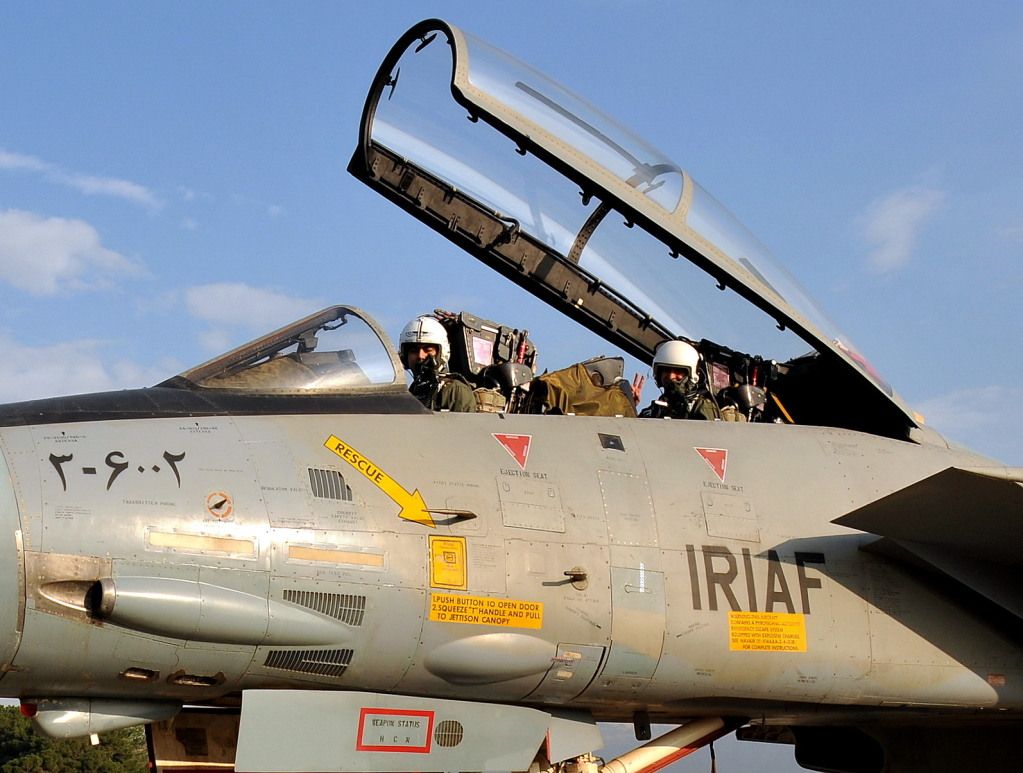
%2Bgrumman%2BF-14%2BTomcat%2Bsupersonic,%2Btwin-engine,%2Btwo-seat,%2Bvariable-sweep%2Bwing%2Bfighter%2Bmissile%2Bbvr%2Blong%2Brange154%2BAIM-54%2BPhoenixaim-7%2B9%2B132%2B(1).jpg)

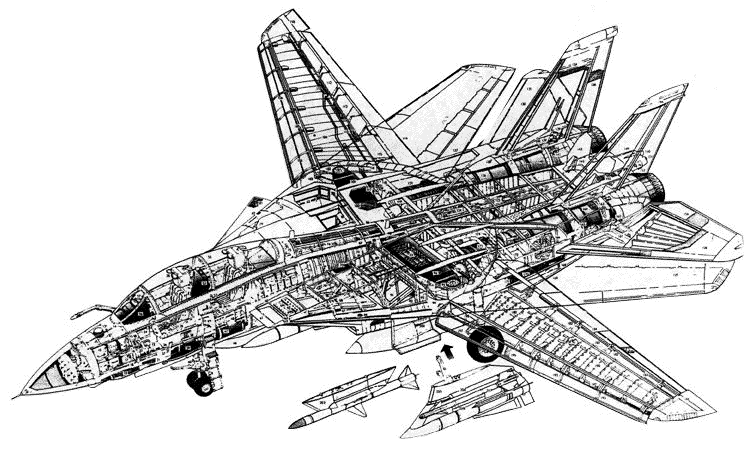
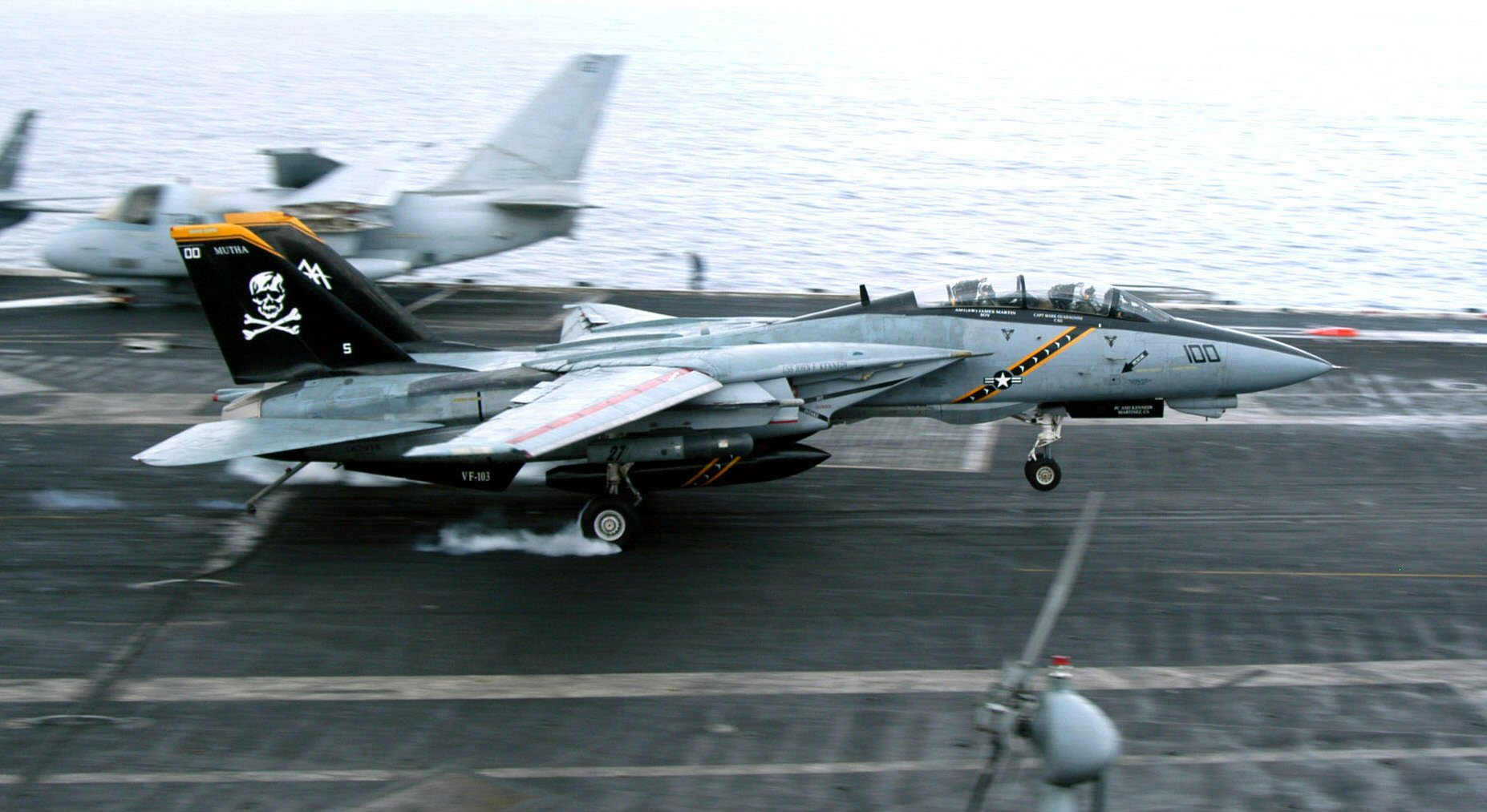
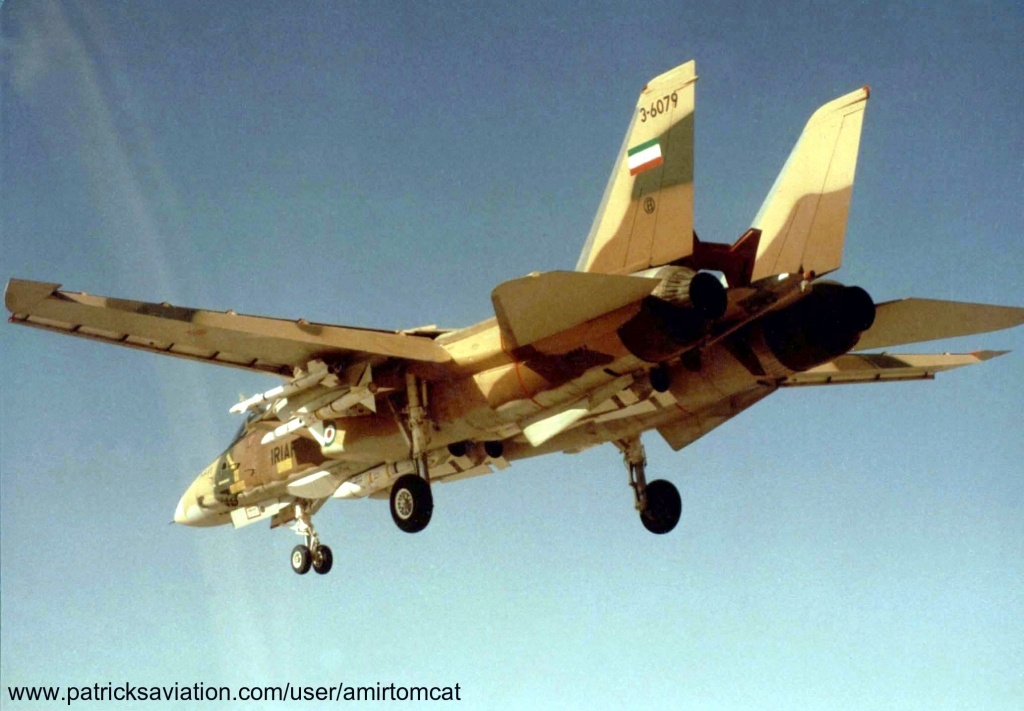
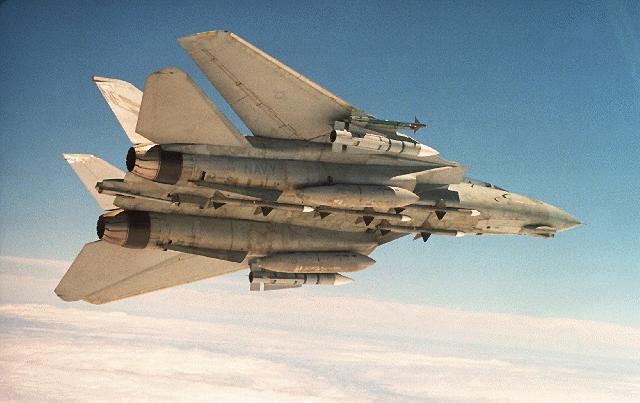

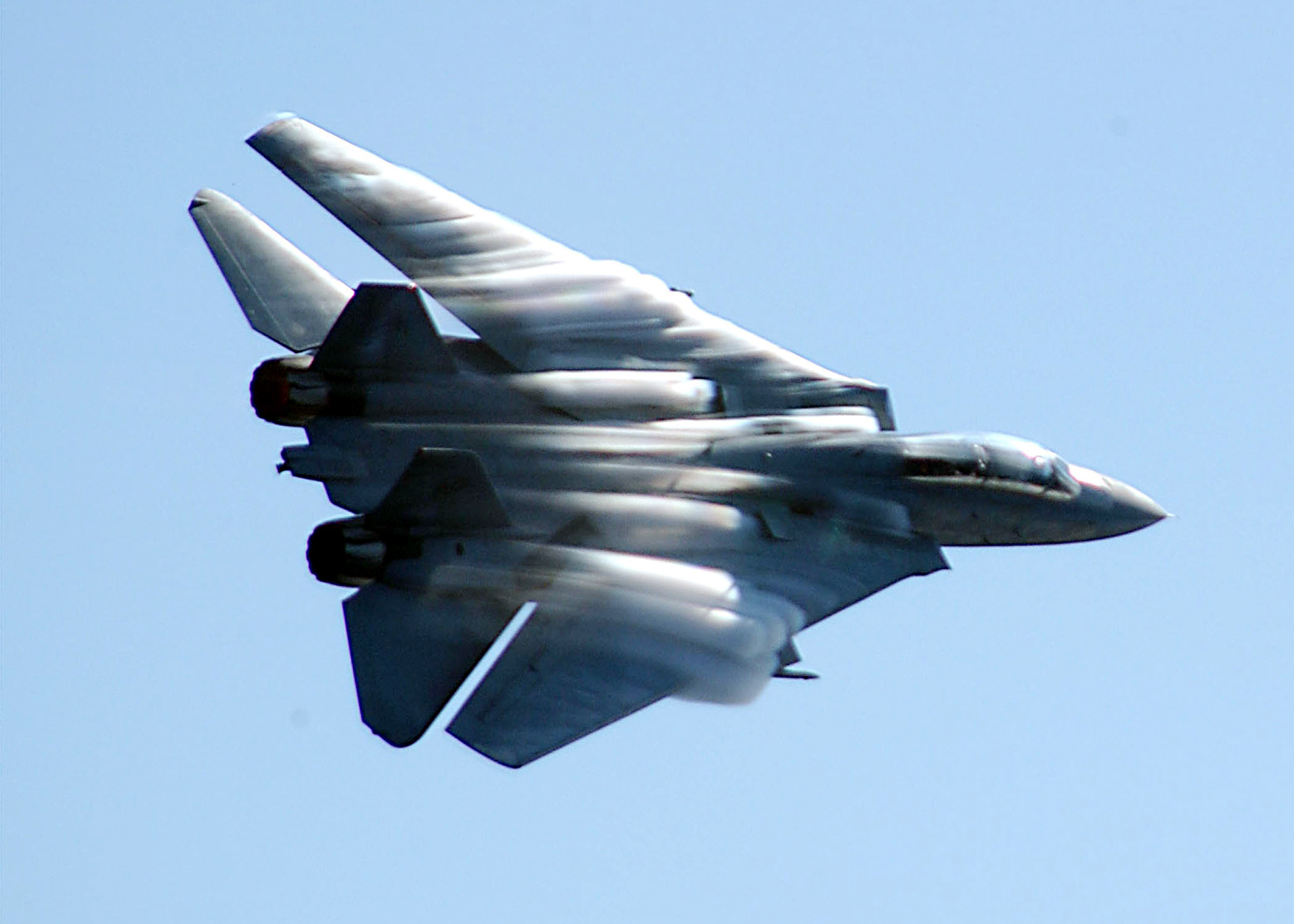


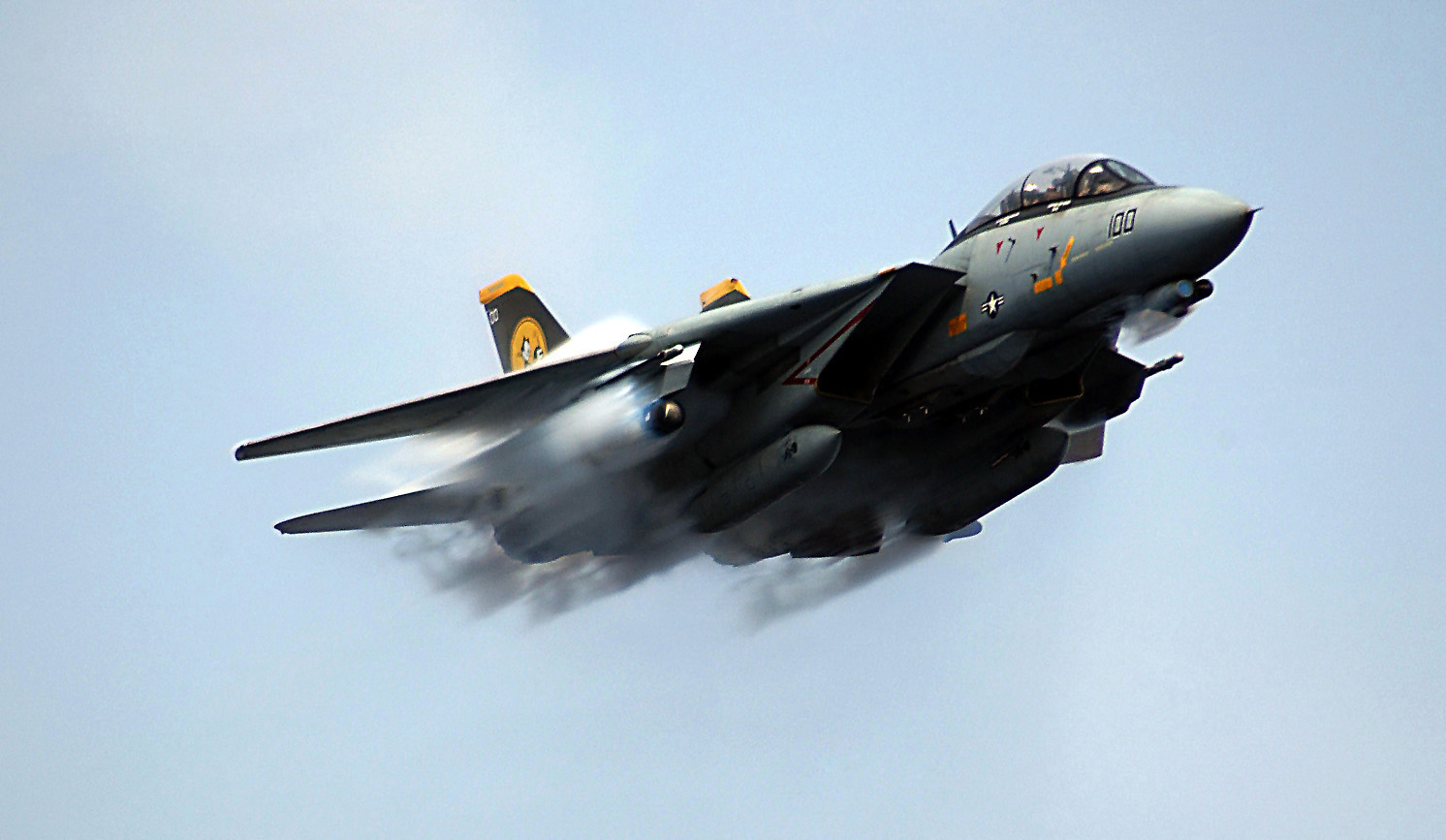
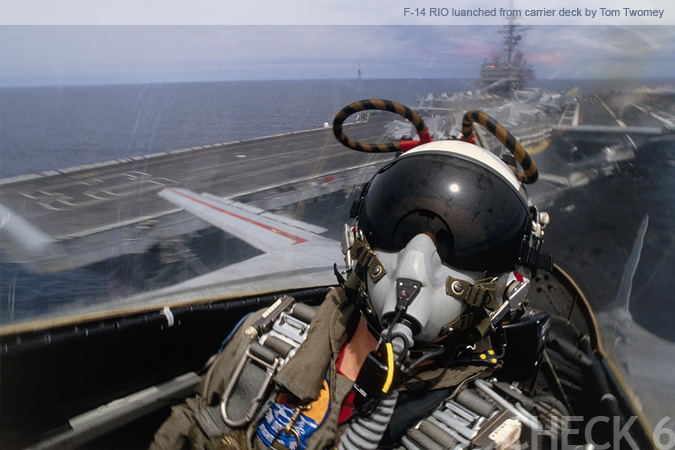



+Bushehr+province+of+Iran.+usn+navy+united+states2+(2).jpg)
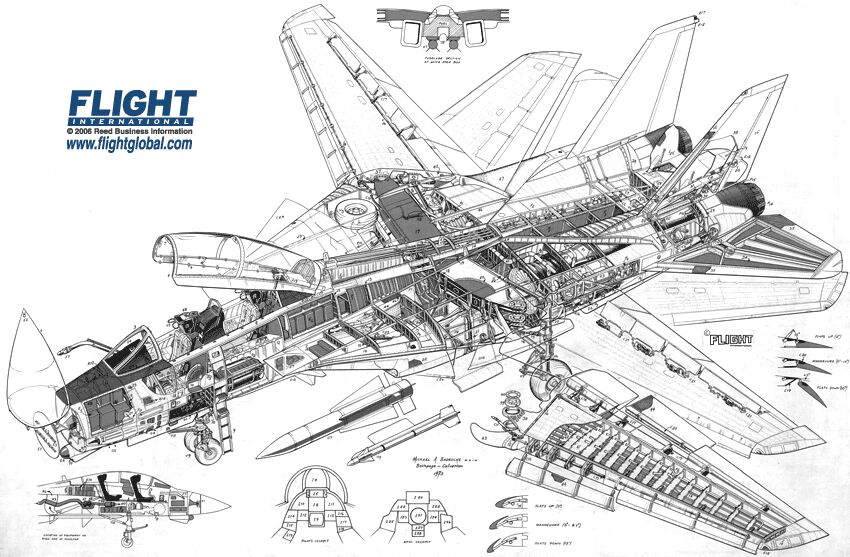
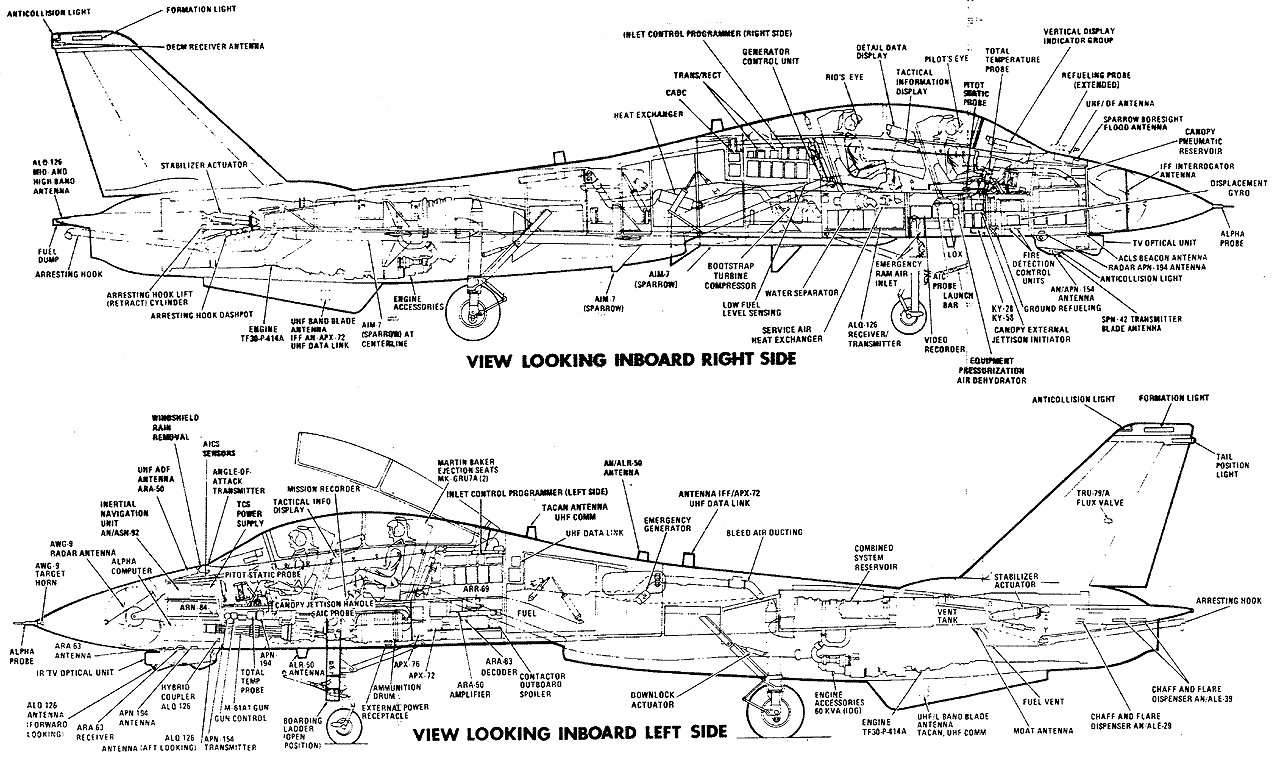

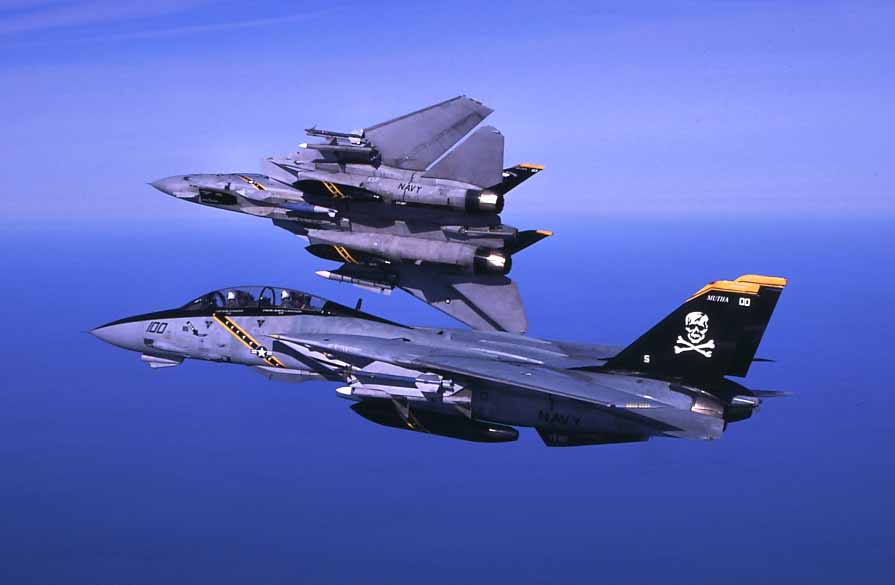

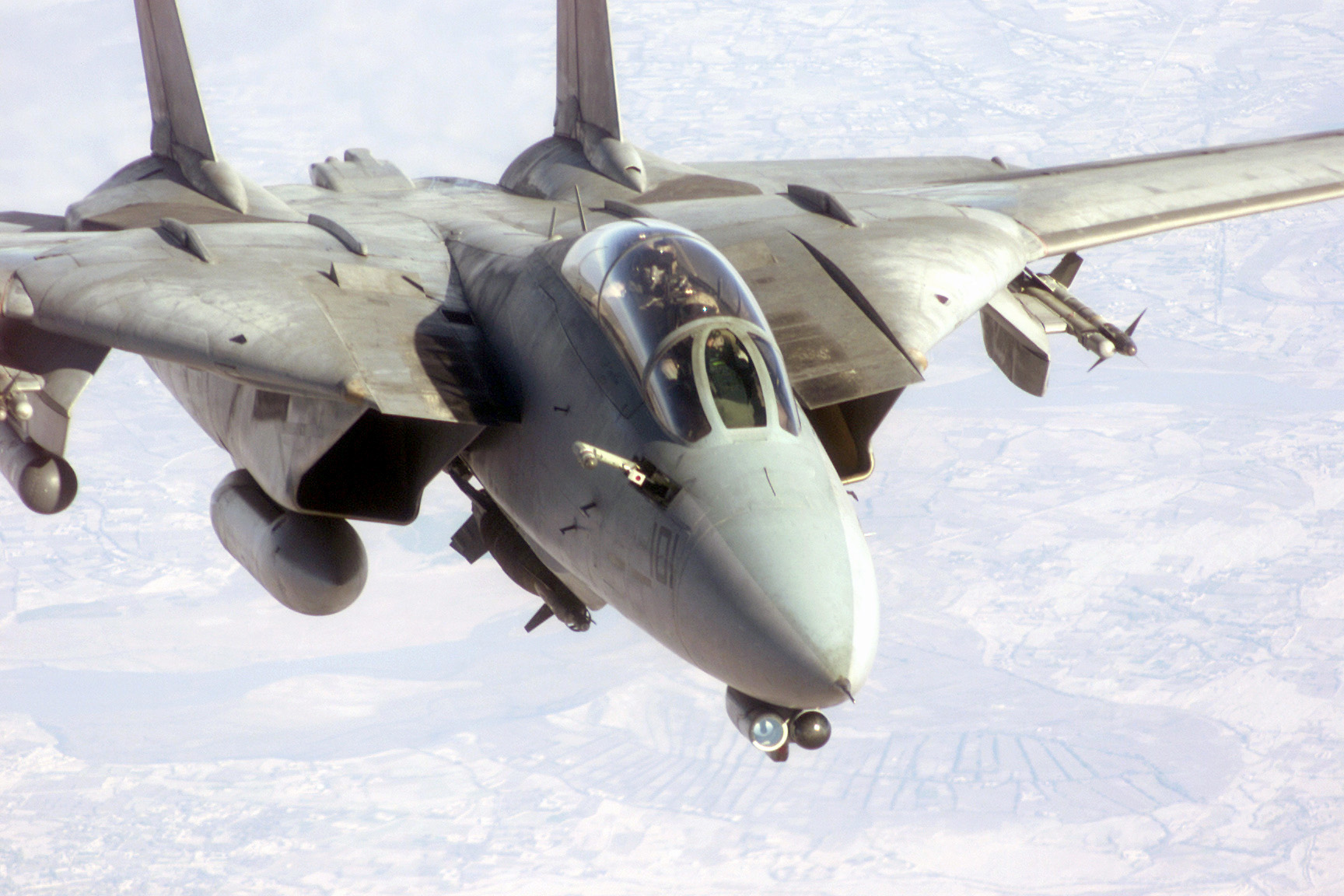
Elite F-14 Flight Officer Explains Why The Tomcat Was So Influential

We
sat at the end of the runway, our F-14's GE-110 motors humming,
awaiting our clearance to begin what would be the last F-14
Demonstration ever. The Air Boss's voice crackled over the radio:
"Tomcat Demo, you're cleared to five miles and 15k feet. The air show
box is yours" At that very moment, I distinctly remember what my
Commanding Officer told us before the show: "Fellas, make it a memorable one… just not too memorable!"
LCDR Joe
"Smokin" Ruzicka was the Radar Intercept Officer (RIO) to fly the last
F-14 Demonstration before the Tomcat's final demise in 2006. Commander
Ruzicka took the time to sit down with Foxtrot Alpha to talk Tomcats and
share his amazing experiences and lasting impressions of being part of
one of the most competitive, demanding and rewarding cultures in
American history- the F-14 Tomcat community.
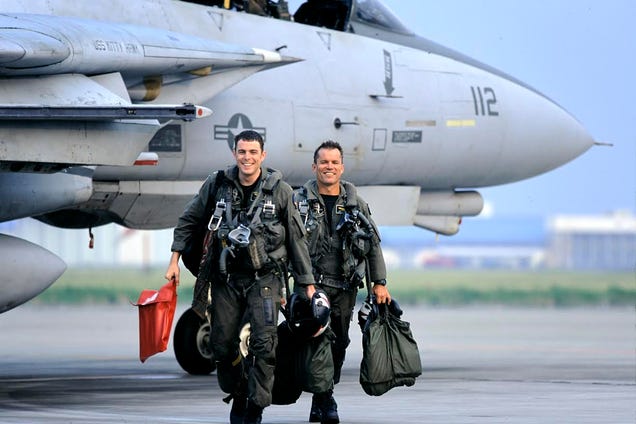
Photo Courtesy of Mr. Yukihisa Jinno
Being in the Navy's premier fighter jet couldn't be a bad thing, right?
My hometown used to have a sign at the city limits that said, "Welcome to Crandall, TX, Home to 1001 friendly people—and a few old grouches." No one from our town, to my knowledge, had ever attended a service academy—not even the old grouches. It seemed like a great opportunity and something that was outside of my comfort zone and probably everybody else's comfort zone I knew at the time.I was accepted to West Point and the Naval Academy, so when deciding between the two, I chose the latter, because it seemed to provide the most flexibility in your post school military specialty. Who wants to pound the ground when you can sail on the high seas? It was in those 4 years at Annapolis where I decided I wanted to fly.When I took the vision test for the commissioning physical my junior year, I tried to pass it without wearing glasses. The nurse administering the exam asked me, "Honey, do you wear glasses?" I replied, "Yes, ma'am." She snapped back, "Well I suggest you wear them from now on, especially when you are driving!" Sadly, I knew my best hope to fly was as a Naval Flight Officer (NFO).Flight school in Pensacola was a great experience. It was essentially USNA South for all of the aviation selectees from the class of 1996. Lots of time spent at the Flora-Bama lounge, golfing on Perdido Key, and of course flying the T-34 Mentor and T-39 Sabreliner.After a couple of cross-country trips to San Diego, I was convinced that the home base of the S-3 Viking was for me. However, a couple of friends who had already been selected for Tomcats convinced me to put my name in the hat for the Big Fighter. Oceana, Virginia didn't sound as awesome as San Diego, but being in the Navy's premier fighter jet couldn't be a bad thing, right?

When two guys had flown together a lot, it made them almost act and think as one person...
When you first showed up to the RAG, you really got a sense of how the two-man crew concept worked. The RIO's (Radar Intercept Officer) responsibilities were completely different than the pilot's, but the two needed to work closely in tandem. Both crew member's relied on each other- even down to the RIO having control of the ejection sequence- because conventional wisdom said the pilot would want to stay with the jet until it was too late.The jet could not be flown, and certainly not fought, without both the Pilot and the RIO. The great part about the two man crew was the mutual respect we shared for each other. I remember a salty pilot telling me one time, "There's been a few bad RIO's who have gotten me in trouble, but then there's also been a few good ones who have saved my ass."With the 1960's technology in the jet and a multitude of sensors, weapons, and equipment, the Tomcat was too complicated and too cumbersome to be controlled by one individual. A typical mission's workload would be divided into segments: think on the ground, administrative in the air, combat, and then administrative back with a final of landing/trapping.During start-up, the pilot handled all of the engines, control surfaces, and other on-board checks while the RIO handled the AWG-9 (radar), LANTIRN targeting pod, a few other systems, clearance with ATC and most other communications. In fact, the RIO probably did 90% of the communication. Most RIOs wouldn't even let the pilots talk on the primary radio; it was a matter of pride and control. I think the pilots liked not having that burden because it allowed them to concentrate on flying.One of the challenges was always trying to cycle circuit breakers when things were broken in the jet. The Tomcat had eight panels of circuit breakers in the back behind the RIO that looked like eight 1970's Lite Bright games all stuck together. The hardest part was making sure you pulled the correct one, as a misstep in that department could be fatal. Pulling circuit breakers was done mostly by feel. Being strapped into an ejection seat, you certainly couldn't turn around easily and verify visually what circuit breaker you were pulling. The good news is there was a method to finding the right circuit breaker based off of its location, assuming you had practiced. The bad news was sometimes you needed to have the flexibility of a 7 year-old girl with a broken arm to reach it!Crew resource management (CRM) dictated what your job was for that specific flight. The majority of the cockpit was "decoupled", meaning there were certain things only the Pilot could perform, and certain things only the RIO could perform. It was a system of checks and balances. This strengthened the crew concept in my opinion, and added to the jet's lethality. When two guys had flown together a lot, it made them almost act and think as one person.For example, on an air-to-ground mission when dropping laser-guided bombs, the RIO's job was to find the target with the LANTIRN pod and designate it. The pilot would verify it was the correct target and then "pickle" (fire) the weapon. Then it was back to the RIO to fire the laser and guide the weapon to impact while the pilot continued to fly the jet, looking for SAMs, etc.For Air-to-Air missions, the RIO worked the radar to acquire the bandit with the AWG-9. The Pilot would correlate the bandit to the threat information called out by the E-2C Hawkeye to ensure it was the correct target. The pilot would then select, arm and select and fire the appropriate missile. Then it was back to the RIO to maintain radar support as the intercept progressed and the missile flew down-range.One of the best training hops was 2 v 1 "the hard way." This was two bandits vs one fighter. In the WVR (Within Visual Range) arena, the pilot kept tabs on the bandit you merged with while the RIO kept sight of the bandit who was free and disengaged. If the RIOs bandit brought his nose to bear (meaning he's pulling back into the fight to take a shot or make a merge happen), then the RIO would call a switch (if the pilot did not move the jet). Then it was back to forcing a neutral pass with the new bandit and trying stiff arm the disengaged bandit. Those kinds of fights get pretty wild and hairy, but they were fun. When two guys were used to flying with each other, these types of complementary actions were where the two man crew was at its best.
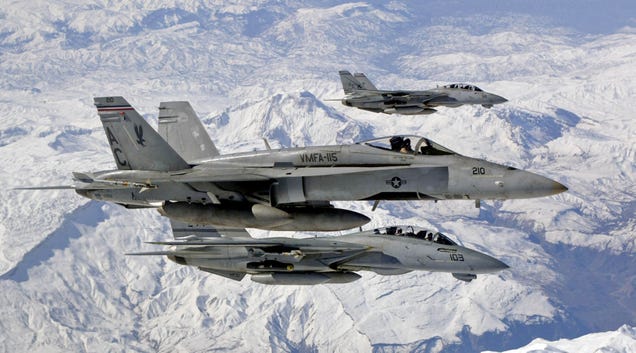
One of the biggest selling points of the two person crew was the Tomcat's ability to perform the Forward Air Controller role...
In the 1970's and 1980's, the Tomcat was primarily an air-to-air fighter. The threat was the USSR and the mission was being able to fend off the hordes of over the horizon bombers. As the times and technology changed, luckily the Tomcat was a pretty versatile multi-role fighter due to its adaptability and modularity. People forget that it had a TARPS pod, which could bring back some pretty awesome wet film photos from a reconnaissance mission. With the addition of the LANTIRN in the early 90s, and later with GPS for the B and D Tomcat models, it was a very viable air-to-ground platform. In fact, I would say as a stand-alone weapon system, the LANTIRN was as good if not better than our current ATFLIR targeting pod on the Super Hornet, specifically from a picture quality and user-friendly standpoint.Finally, one of the biggest selling points of the two person crew, was the Tomcat's ability to perform the Forward Air Controller (Airborne) role known as "FAC(A)." The FAC(A) role increased as the GWOT evolved. In fact, my old squadron, the Black Knights of VF-154, was providing FAC(A) under CENTCOM for numerous USAF and Navy assets during the early stages of Operation Iraqi Freedom.As a FAC(A), your role is to coordinate air strikes from available air assets in an effort to support troops on the ground. The theory is that as an airborne asset, the FAC(A) has the ability to see the battlefield in the same perspective as the striking jets. In this sense, the goal is to eliminate any and all fratricide because the FAC(A) has the ultimate authority to give a "Cleared Hot" call (authorization to release weapons) to other strikers. The FAC(A) knows exactly where the friendlies are in relation to the target and can see the strikers nose position relative to the target, thus determining if there is a chance of bombs not ending up on that target.In the Tomcat, the pilot's job was to maneuver the jet to get into a position where he could give a "Cleared Hot" call. With multiple strikers inbound separated by time (normally 30 seconds to a minute), this could be a challenge. Typically, one striker is off target with bombs away while the next striker is inbound and in a dive. This is where the RIO tends to earn his money as he visually acquires the inbound striker, talks his pilot's eyes onto him, and then switches to see where the first striker's bombs' hit. When you add SEAD and artillery coordination, close proximity of friendly troops, buddy lasing (having one jet designating a target while another drops the weapons) for laser guided bombs and a MANPAD being launched at someone, it becomes a dynamic and challenging mission; one where two aviators in the cockpit provides an added level of tactical advantage and situational awareness.
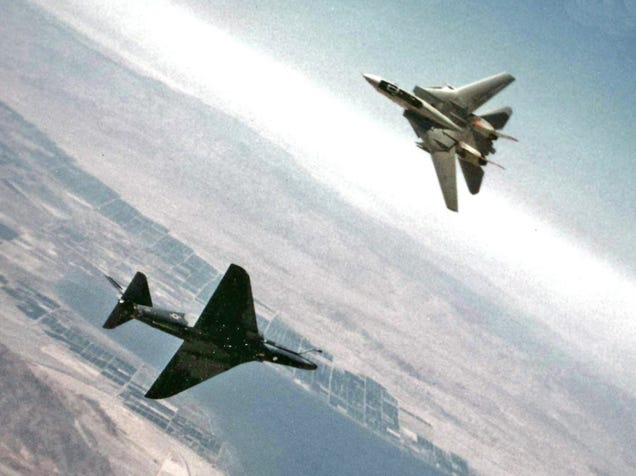
The Tomcat's ability to add energy and head into the vertical was a serious advantage over the Super Hornet...
In a BFM (Basic Fighter Maneuvers ie a dogfight) engagement, the pilot has to think about energy management. Fighter pilots always talk about a Rate vs a Radius fight, which in layman terms means how fast can you go around the circle you are turning versus how short of a radius can you make your circle. Some Fighters perform better in a rate fight while others perform better in a radius fight.For example, if a Tomcat was in a BFM engagement with a Super Hornet, the Tomcat's best chance to win the fight (we are assuming "Sticks and Stones" meaning each fighter has only a gun remaining) is to try and force the Super Hornet to bleed off energy at the first pass. The Tomcat would force the Super to honor his nose position, make a neutral pass at the merge and then go vertical. The Tomcat's ability to add energy and head into the vertical was a serious advantage over the Super Hornet. Conversely, the Tomcat would not want to get into a slow speed fight with the Super. With both jets at slow speed, the Super has a better ability to maneuver his nose for a shot than the Tomcat.The F-15C is probably the premier BFM fighter and more capable in that area than the Tomcat. You have to remember, the F-15C has a 9G turning capability versus 6.5 to 7.0 G for the Tomcat. But the F-15C is strictly air-to-air, so there are trade-offs in capabilities between the two jets.They don't drop bombs, we do. Another thing: a lot of success in BFM has to do with the pilot's ability to maximize the jet's capability. Fortunately, the best trained guys who fly the F-15C are on our side!
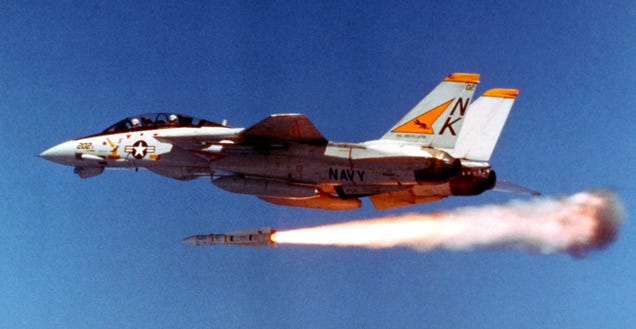
The idea was to make at least one of the enemy fighters blow up in front of his wingman's face, thus making him think twice about pursuing us...
Our squadron did a night AIM-54 Phoenix shoot where we shot two Phoenixes at range against a drone. The shots were staggered by about 2 miles, one right after the other. Our lead safes, while on NVG's, followed both missiles toward the target. They reported back that the first Phoenix was "Boola Boola", meaning a direct hit and completely destroying the drone. They said what happened next was pretty amazing. The second Phoenix quickly made an adjustment off what was left of the drone and hit the largest remaining part. Remember, this 1,000lb missile is traveling at Mach 3.0 and only a couple of miles behind the first missile, so there was very little time for the missile to react. I guess the Ordies had programmed it for "pulverization mode".The good thing about the Phoenix was its range. We used to brief that we would shoot one Phoenix at "range" (and I won't say what that range was, but it was far) into any unresolved group of aircraft declared hostile. The idea was to make at least one of the enemy fighters blow up in front of his wingman's face, thus making him think twice about pursuing us.The bad thing about the Phoenix was it's old technology, which made it cumbersome and sometimes not function properly. It required its own cooling pump and sometimes the rocket motor wouldn't fire, making the missile fall dead off the rails. This earned it the not so glamorous nickname "Phoenie-Bomb".It's hard to say whether the Tomcat would have benefited from the AIM-120. Certainly a newer missile with newer technology would have been a great addition, but could it have been adapted to the platform and the AWG-9 without a huge cost?
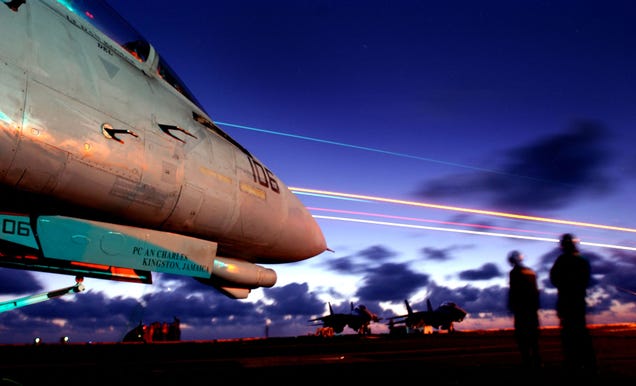
The scary part about landing on the boat at night is everybody has a scary story. That's A LOT of scary stories...
People always talk about how difficult it is to land on the boat, but I think that idea should be broadened. Most don't realize how DAMN difficult it is to simply get launched off the pointy end, go fly a mission with live weapons, get to marshal with enough gas for an approach AND THEN attempt a crashed landing on a floating, moving object at night and in bad weather.There are so many moving parts to carrier operations at sea. Space is such a premium, the boat becomes the world's worst Rubik's cube: in the hangar bay, on the flight deck, and in the confined operating sea spaces. Gas is as scarce as water is in the Sahara; the only tanker is another Super Hornet and he only has enough gas to give you 1.8 passes at the ship (BTW, .8 passes doesn't help you much). Simple maintenance and parts supply becomes much more restrictive. There's very little room to work on the jet and your parts are whatever the boat has in its stock. Finally, the boat has the requirement to launch aircraft while still being a ship—both from a training perspective and an operational perspective. When your runway has to float, cook everyone a meal 4 times a day, and do a bunch of laundry using nuclear power—it just adds another layer of operational difficulty.I'm glad I don't have any more night traps. Go stand in one corner of a really dark room with a small pen light at the opposite end. Look through a paper towel tube searching for that light. If you find it, that's what the boat looks like at night from 20 miles.The scary part about landing on the boat at night is everybody has a scary story. That's A LOT of scary stories. However, landing on the boat at night is what sets us apart from every other Navy (and Air Force) in the world.I don't know which is worse, being the guy in front who has control of the jet or the guy in back who only has control of the ejection seat. Thankfully, I rode along with some outstanding pilots during the majority of my night traps.
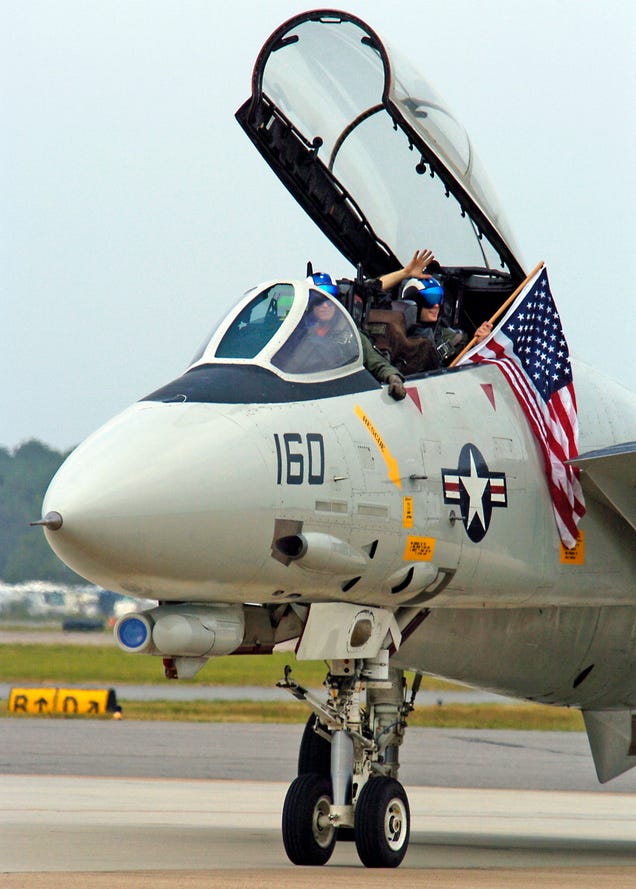
The final year of the demo and the Tomcat's sundown were bitter sweet...
I guess everybody gets 15 minutes of fame in life and I was lucky enough to spend mine strapped into the most iconic fighter in the world. The Commanding Officer of VF-101, Paul "Butkus" Haas, picked "Rocco" Tangredi and I to fly the final F-14 Tomcat Demo in front of the home crowd at NAS Oceana, Virginia, and it was one hell of a ride.I like to think that flying the Tomcat Demo was pretty much within the capability of every Tomcat pilot and RIO who had a reasonable amount of time in the jet. There was nothing special about us in terms of skill, we just worked hard and got lucky. Out of the 4 of us selected for the final year, two guys went on to become Blue Angels and the other two flew the very last Tomcat Demo. It would be fitting to say Rocco and I got a decent consolation prize.The Tomcat Demo was always a crowd favorite (probably right behind the Blues in terms of popularity) and it even amazed Tomcat pilots themselves. I remember talking with "Lucky" Riley one time about the dirty (landing gear extended) double Immelmann. Lucky said he was watching a practice show and he incredulously remarked to himself, "they do an Immelmann dirty?!! Oh my. And then they do another one on top of that one???" I told him we got a Flap warning light during the second Immelmann, meaning we were over speeding the flaps. The damn jet was GAINING ENERGY in an upside down dirty configuration!!! Those GE-110 engines were impressive.The final year of the demo and the sundown were bitter sweet. You knew it was the last time a lot of folks were ever going to see the jet fly. Some of my favorite shows included Ft. Lauderdale, Chicago, and my hometown show at the Fort Worth Joint Reserve Base. It's always fun to perform in front of family and friends. When we taxied by the crowd I would look for my dad. He is an old University of Texas Longhorn grad, so when I spotted him I would give him the Hook 'em Horns sign from the jet, that way he knew I saw him and my Mom.There were tons of Tomcat fans who reached out to us before and after the final show. We had folks from Europe and even Japan travel to see us in the last year of the demo. It's been nine years and people still occasionally contact me asking for autographs. People always say it was their favorite jet and I believe it. That's a pretty impressive following for the Big Fighter.There is a great caption in the book Bye Bye Baby about our show at Nellis Air Force Base where the F-22 made its first airshow appearance. I can't do the caption justice, so you'll have to read it yourself, but I think it captures the essence of how we went out with a bang in our final year.
Tyler's note: The excerpt from Bye Bye Baby Smokin is referring to is this:
"I was at
the big Nellis Air Show, and everybody was buzzing about the first
public demo of the F-22. Lots of generals in the bleachers, the whole
deal. The F-22 was just plain lame. Hard deck of 1000 feet AGL, weak
turns, no high-speed passes. Like they're afraid to break the thing,
which they were. Who's up next on the schedule? Why, the Tomcat, of
course. These guys just beat the place up. Flogged this Air Force base
mercilessly. The crowd goes bananas, and I'm yelling along with them.
Tell me who those two lunatics were, and I'll buy them a cocktail."
–Brian "Punchy" Shul, SR-71 Blackbird Pilot
I don't recommend, I DEMAND that you buy Bye Bye Baby and read for yourself this and the many other funny, terrifying and thrilling accounts from the Tomcat's long career.
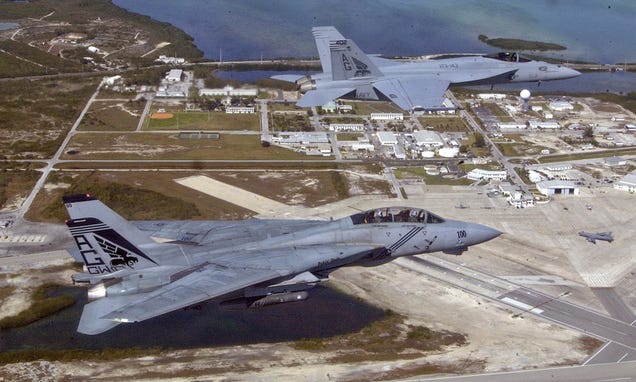
The Super Hornet is an awesome aircraft, but I fear a lot of its greatness comes from technology...
The best way to describe the differences in the two platforms is to use the analogy of a muscle car to a mini-van, with the Tomcat being the former and the Super Hornet being the latter. The muscle car doesn't have much to it in the way of fancy technology, just some raw speed and the coolness of a Steve McQueen movie, but it gets the job done. The mini van on the other hand is a very nice car, complete with DVR's for the kids, Air Conditioning, power windows, and lots of places to put your sippy cup. It's a great car—-but it's still a mini-van.Don't get me wrong, the Super Hornet is an awesome aircraft, but I fear a lot of its greatness comes from technology. In the Tomcat, I think you had to be a better aviator because the technology just wasn't there. It was up to the aircrew to maximize its performance (or minimize it if you sucked). Conversely, in a Super Hornet loaded with APG-79 (AESA radar), MIDS (advanced data link), ATFLIR (advanced targeting pod), AIM-9X (high-off boresight air-to-air missile) and JHMCS (helmet mounted display), you can be a sub-par aviator and let the technology pick up the slack.I don't want to completely slight the Super Hornet crowd. They've been given a great airplane and are doing great things with it even as this is being written (the USS George Bush is currently underway readying for Iraq). But the level of commitment, money, time, and effort it takes to get a guy up to speed and maintain proficiency in all mission areas is a pretty difficult challenge. Furthermore, I am concerned that what we've come to in the last few years with only the Super Hornet in the carrier aviation fleet is an aircraft and aircrew that are "jacks of all trades, masters of none".Every aviator will tell you that your skills erode very quickly if not practiced. Unfortunately, it's pretty tough to practice every mission, on every flight, every time you fly, especially in our current political and financial environment.

That thing can make one hell of a bat turn...
We've really made a huge leap in technology over the past 10 years. AESA radars along with the AIM-9X, MIDS, and JHMCS have completely revolutionized fighter aircraft. The Air Force will balk and throw "stealth" in there as a quality, but they don't land on carriers. My Maintenance Master Chiefs would/will love that corrosion control program (on the F-35C).If you have a Super with AESA, you've reached the pinnacle of the jet's capabilities. The air-to-air mode is superior to anything I ever saw in the Tomcat, particularly in terms of user friendliness. The air to ground mode has superb resolution. The radar can in theory, run air-to-air and air-to-ground simultaneously. I like to think of the AESA as a snow plow that catches snow in the air while also moving it off the ground. Pretty awesome if you ask me. If we were not making revolutionary improvements to our inventory you would have to be worried.Probably even more revolutionary is the AIM-9X with a JHMCS used in the WVR (dogfight) arena. Imagine flying in spread formation at a mile apart, looking over your right shoulder and designating the guy you are about to fight. After "FIGHTS ON" is called, the next words out of your mouth could be "FOX-2" (launching of a short ranged missile). Yikes! That thing can make one hell of a bat turn.If you could add anything to a jet that would make a significant weapons impact it would probably be a powerful and robust Infrared Search & Track (IRST) system. Technology has figured out how to hide from radar, but we haven't really figured out how to hide or diffuse heat very well. An IRST with some decent range and ability to avoid ground clutter could be a game changer.Unfortunately, we might still be at the concept stage with that idea.
Tyler's note: The Super Hornet will be fitted with an IRST on its centerline tank in the near future, the USAF is actively debating fielding a IRST for its fighter aircraft, namely the F-15C, as well.
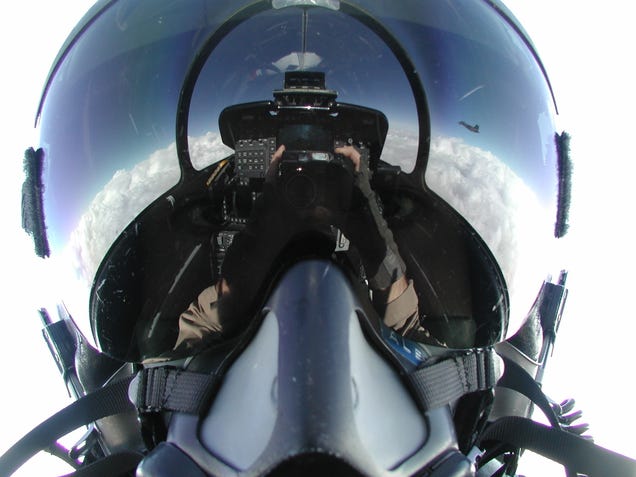
You are still a co-pilot, not just R2D2 in the back...
The hardest part for new WSO's (Weapon Systems Officers) is to not get "sucked inside" the cockpit by all of your sensors. You are still a co-pilot, not just R2D2 in the back. I used to tell new guys to strive for looking 50% inside the jet and 50% outside the jet. By looking outside you build air sense and situational awareness. This makes you a better crew member/co-pilot, which is the ultimate objective. Unfortunately for new guys, the ratio was 90% inside, 10% outside, but that is why you train.I loved flying with the USMC at their Fleet Replenishment Squadron (what RAGs are called now), VFMAT-101, in Miramar. We had an exceptional bunch of guys as instructors there—both Navy and USMC. It's so frustrating that the Navy gave Miramar up because it is THE premier location for flying fighters. It's proximity to San Clemente Island for Field Carrier Landing Practice (FCLP), El Centro for live bombing, and a TACTS range for air-to-air engagements, combined with 350 days a year of great weather make it a dream. Oh, and by the way—when you land—you are in San Diego. I feel lucky to have experienced it like the Tomcat bubbas did in the late 1980s.The two services have different approaches to their air power assets. The USMC is all about Close Air Support and protecting Marines on the ground. The USMC's mission is quick strike, knock down the door. They really emphasize the Air-to-Ground mission with the Hornet being one of many assets in the Marine Air-Ground Task Force (MAGTF).The Navy adds more balance into their approach with Hornet missions. The USN has to protect the CVN/strike group, a mission that calls for a more defensive mindset than the USMC's. Additionally, there are numerous other critical missions such as surface search, self-contained large force strike packages and close air support missions.
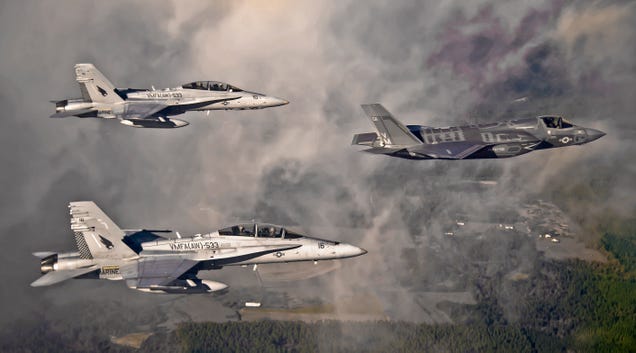
The bottom line concern is does the F-35 meet our needs for the price...
We have some real challenges with the F-35. In fact as I write this, the entire JSF fleet has been grounded for an engine fire . Not a good thing at this stage of development, especially considering its past history. When the B variant breached Nunn-McCurdy (a large cost overrun) back in 2010, the program was really struggling. To me, the problems with the B version seemed pretty simple—the more parts that move the more things break! Unfortunately, there is not a good answer for the problems with the other two versions.In the F-35's team's defense, we are really building 3 different jets. Furthermore, there are some serious international relations issues (maybe self inflicted) that complicate matters. Fortunately, we have some really great, sharp, capable people working on the project and doing their best to make this program succeed. We desperately need it to succeed. It's a testament to the USA's ingenuity and capability.However, when you step back and take a strategic look at the program, the bottom line concern is does the F-35 meet our needs for the price? I would say the jury has not yet made up their mind on this question, but much like the OJ trial, they are tired of sitting in court waiting for the lawyers to finish their case.

Drones are cheaper than fighters, they don't get sick like pilots, and most of all, they don't have a guaranteed pension...
UCAV's and helo's are the future. In 25 to 30 years, you better be able to hover or be good at video games. This is because your best chance of flying will be in a helicopter or flying a drone from the proverbial phone booth. UCAV's also make financial sense. Drones are cheaper than fighters, they don't get sick like pilots, and most of all, they don't have a guaranteed pension.A good friend of mine and former Tomcat pilot Greg "Drano" Malandrino, along with Jeff "Lick" McClean wrote an excellent article for Foreign Policy magazine that describes the best and hopefully most probable outcome for integrating drones into our current force. Additionally, I recently read a great book called The Second Machine Age that speaks to our world's ongoing rapid technology development and how humans need to work with the machine to unleash our full technology capability and ingenuity. Drano and Jeff's article is an excellent discussion and application on how our battlefield integration with UAV's captures the idea of working with the machine.

Photo via AP
He's a little ornery, but very sharp and witty and has a motor that puts a lot of 20 something's to shame...
What's the old saying, "I'd rather be lucky than good?" Well, I was very lucky to be selected as John McCain's Legislative Fellow for 2011.The most common question I get is "What's he like?" and I always answer the same way: he's kind of like your grandpa in that he's a little ornery, but very sharp and witty and has a motor that puts a lot of 20 something's to shame. I think he would have made a great president. Unfortunately, he's going to have to settle for being a Great American, but that's pretty darn good.I was fortunate to collaborate in writing his remarks for the 100th Anniversary of Naval Aviation at Tailhook and additionally be the assigned staff member during his visit to the convention. One of the best meetings during our time there was between the Senator and his old Commanding Officer, Admiral "Doc" Abbot (then in his 90s). They probably had not seen each other in close to 40 years. Time stood still for a moment as the two talked like they were back together on the USS Intrepid. I don't think I've ever heard the Senator say "sir" so much in one conversation.Inside the Beltway is really its own battlefield. Peeking behind the curtain you realize how difficult it is to affect change and how most issues don't just have a left or right view point, but a full 360 degrees of viewpoints. I have faith in the system but unfortunately, a lot of American's currently don't. Every good idea should not be a law, so the checks and balances are there for a reason—even if it seems like nothing ever gets done.The financial challenges within the DoD and Navy match the same financial challenges currently in front of the country as a whole. Paying for pensions and medical care inside the military sounds a lot like paying for Social Security and Health care out on Main Street USA. With a finite amount of money, lawmakers and DOD leadership are looking for pathways to curtail spending. The problem is when those cuts dig into an earned benefit. I think everyone saw the potential political suicide last year when Congress voted to reduce working age retirees' cost of living adjustments.
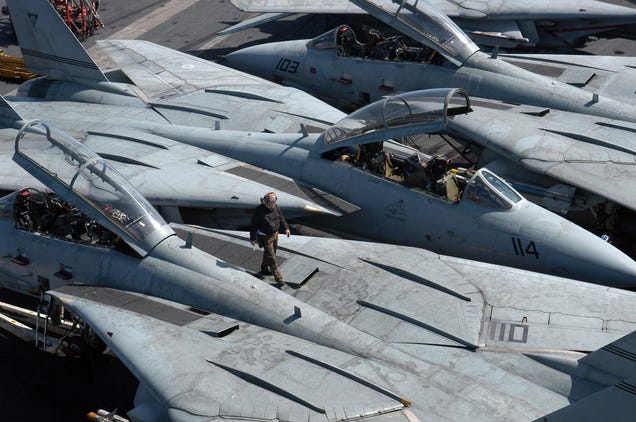
I don't think we will ever have a plane that captures and defines a culture as strongly as the F-14 Tomcat did...
I always like to say there are two kinds of people in this world: those who were a part of it (the Tomcat Community) and those who wish they were. I don't think we will ever have a plane that captures and defines a culture as strongly as the F-14 Tomcat did. It was camaraderie, hard work, fun, rock and roll, and sex appeal all rolled into one. Sure we had a movie made about us, an awesome looking jet, and a fan base that could rival the New York Yankees, Dallas Cowboys and Notre Dame all rolled into one (well maybe not Notre Dame). But the culture was much more than Tom Cruise riding his motorcycle down the runway—it was a sense of teamwork, pride, and family.Our maintenance personnel loved the jet probably more than the pilots and RIOs who flew in it. A lot has been made about how the maintenance hours on the Tomcat were a factor in its retirement and how it was often broken. Let's face it, when you slam a jet down on the deck of an aircraft carrier and then launch it off the front end again—doing this repeatedly in a saltwater environment—you are likely to bend and break a few things. Additionally, when your logistical parts supply line stops at the waterline and you aren't able to drive down to the depot and pick another part off the shelf, your ability to repair jets becomes a pretty big challenge. The Air Force does not have to face these types of challenges and it's only a matter of time, if not now, for the Hornet crowd to face the same problems.I don't want to dispute how tough it was to keep it flying, but I will say everyone who worked on the Tomcat felt like it was an earned privilege. Furthermore, I have been in Tomcat squadrons with sortie success rates better than the Hornet. I know if you asked Master Chief Steve "Woody" Woods, and probably a couple hundred others, if they wanted to come out of retirement to get the plane flying again, the word "yes" would come out of their mouths probably before you finished your sentence. We asked a lot from our maintenance folks and they delivered.
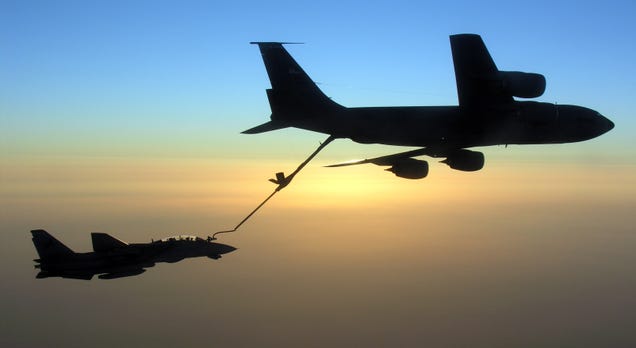
Photo via AP
Guys use the term "Bag Strike" when you go out on the town in your flight suit...
Did the flight suit and the Tomcat's notoriety help with the ladies? Hell yes. When you have a face for radio, a flight suit tends to help make your Goonies appearance fade into the background. What does Jerry Seinfeld say? The actual percentage of people considered "good looking" is around 4%. Well, for the other 96% of us, you better have something that sets you apart! You've still got to bring a little personality to the table, but for most fighter guys that is not too much of a problem.Guys use the term "Bag Strike" when you go out in town in your flight suit. One fall we were asked to do the pregame flyby at a Kansas City Chiefs game at Arrowhead. We arrived in KC earlier in the weekend and hit all the BBQ joints and local bars. On Sunday, after performing the flyby, we were invited up into the owner's box (Mr. Lamar Hunt), got a tour of the stadium, met a few cheerleaders—pretty much the works. Let's just say there was a lot of "bag striking" going on that weekend and even a few confirmed kills.
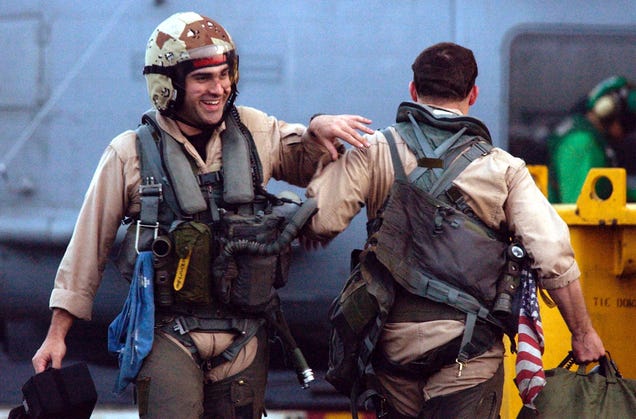
Photo via AP
Most guys and gals who fly fighters know their strengths and hide their weaknesses...
A lot of people think we are all arrogant, and while that is probably true, I would rather use the term "self-confident." Most guys and gals who fly fighters know their strengths and hide their weaknesses. It's simply human nature and people do it to survive in a Ready Room environment. Some guys use the "volume makes you more correct" mantra, as long as I talk loud and often, people think I know what I am talking about.Most are family guys who don't get to spend enough time at home. With deployments stretching 9-10 months, family time is precious and dwindling. It's tough for guys who have kids because you don't get to see enough of them. I think this is going to be a major issue where more money (i.e. bonuses) won't solve the problem. Leadership better take a hard look at dwell/rotation time or there will be lots of MBA programs filling up with ex-Navy personnel.I think for the most part women have integrated well into the culture. There have certainly been a few women who probably should not have been fighter pilots; but for every one of the women who was not cut out to do the job, there were probably also two guys there who you were scratching your head about. It's all about doing your job and making an impact. If you can do that—you're on the team.As far as how I think we can improve the Navy from a fighter crew's perspective, let a cruise experienced Junior Officer (JO) provide some strategic level input. There are way too many good ideas being drawn on an O Club bar napkin every Friday night that should not be thrown out Saturday morning with the beer bottles. The Navy chain of command needs to listen from below A LOT MORE than it currently does, or the Navy is going to have a difficult time over the next 10-15 years, particularly in regards to retention.
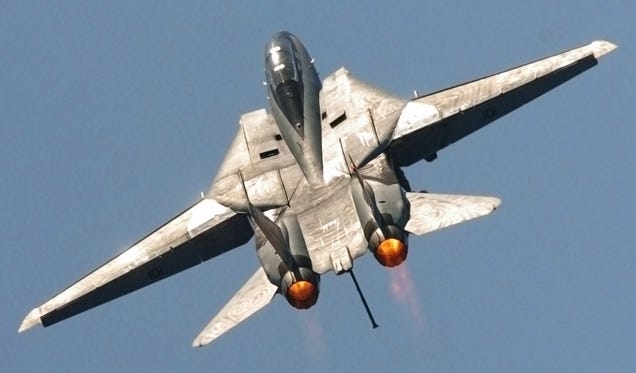
More about LCDR Ruzicka:
"Smokin"
Joe Ruzicka is a recovering Naval Aviator, much like his old boss John
McCain. He currently flies a desk at the Navy International Programs
Office in Washington D.C. Look for him to make a run for Congress in
2020.
Foxtrot
Alpha would like to thank LCDR Ruzicka for spending the time to share in
his own words his thoughtful insights and fantastic stories with our
readership, and thank you Joe for your service and those fantastic
Tomcat Demos as well! We wish you well in your future endeavors and
please come back and share another story or two or chime in a hot topic
whenever you feel like it.
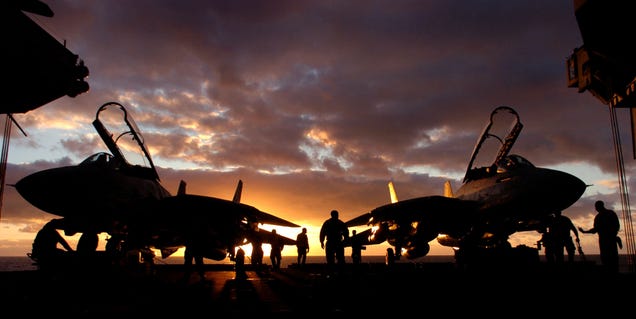
All photos via the DoD, or Public Domain except were marked
Tyler
Rogoway is a defense journalist and photographer who maintains the
website Foxtrot Alpha for Jalopnik.com You can reach Tyler with story
ideas or direct comments regarding this or any other defense topic via
the email address Tyler@Jalopnik.com
Grumman F-14 Tomcat
From Wikipedia, the free encyclopedia
| F-14 Tomcat | |
|---|---|
 |
|
| A U.S. Navy F-14D conducts a mission over the Persian Gulf-region in 2005. | |
| Role | Interceptor, air superiority and multirole combat aircraft |
| National origin | United States of America |
| Manufacturer | Grumman Aerospace Corporation |
| First flight | 21 December 1970 |
| Introduction | 22 September 1974 |
| Retired | 22 September 2006 (United States Navy) |
| Status | In service with the Iranian Air Force |
| Primary users | United States Navy (historical) Imperial Iranian Air Force (historical) Islamic Republic of Iran Air Force |
| Produced | 1969–1991 |
| Number built | 712 |
| Unit cost |
US$38 million (1998)
|
The F-14 first flew in December 1970 and made its first deployment in 1974 with the U.S. Navy aboard USS Enterprise (CVN-65), replacing the McDonnell Douglas F-4 Phantom II. The F-14 served as the U.S. Navy's primary maritime air superiority fighter, fleet defense interceptor and tactical reconnaissance platform. In the 1990s, it added the Low Altitude Navigation and Targeting Infrared for Night (LANTIRN) pod system and began performing precision ground-attack missions.[1]
The Tomcat was retired from the U.S. Navy's active fleet on 22 September 2006, having been supplanted by the Boeing F/A-18E and F Super Hornets.[2] As of 2014, the F-14 was in service with only the Islamic Republic of Iran Air Force, having been exported to Iran in 1976, when the U.S. had amicable diplomatic relations with Iran.
Contents
Development
Background
Beginning in the late 1950s, the U.S. Navy sought a long-range, high-endurance interceptor to defend its carrier battle groups against long-range anti-ship missiles launched from the jet bombers and submarines of the Soviet Union. The U.S. Navy needed a Fleet Air Defense (FAD) aircraft with a more powerful radar, and longer range missiles than the F-4 Phantom II to intercept both enemy bombers and missiles.[3] The Navy was directed to participate in the Tactical Fighter Experimental (TFX) program with the U.S. Air Force by Secretary of Defense Robert McNamara. McNamara wanted "joint" solutions to service aircraft needs to reduce development costs, and had already directed the Air Force to buy the F-4 Phantom II, which was developed for the Navy and Marine Corps.[4] The Navy strenuously opposed the TFX as it feared compromises necessary for the Air Force's need for a low-level attack aircraft would adversely impact the aircraft's performance as a fighter .VFX
The F-111B had been designed for the long-range Fleet Air Defense (FAD) interceptor role, but not for new requirements for air combat based on experience of American aircraft against agile MiG fighters over Vietnam. The Navy studied the need for VFAX, an additional fighter that was more agile than the F-4 Phantom for air-combat and ground-attack roles.[7] Grumman continued work on its 303 design and offered it to the Navy in 1967, which led to fighter studies by the Navy. The company continued to refine the design into 1968.[5]In July 1968, the Naval Air Systems Command (NAVAIR) issued a request for proposals (RFP) for the Naval Fighter Experimental (VFX) program. VFX called for a tandem two-seat, twin-engined air-to-air fighter with a maximum speed of Mach 2.2. It would also have a built-in M61 Vulcan cannon and a secondary close air support role.[8] The VFX's air-to-air missiles would be either six AIM-54 Phoenix or a combination of six AIM-7 Sparrow and four AIM-9 Sidewinder missiles. Bids were received from General Dynamics, Grumman, Ling-Temco-Vought, McDonnell Douglas and North American Rockwell;[9] four bids incorporated variable-geometry wings.[8][N 1]
Upon winning the contract for the F-14, Grumman greatly expanded its Calverton, Long Island, New York facility for evaluating the aircraft. Much of the testing, including the first of many compressor stalls and multiple ejections, took place over Long Island Sound. In order to save time and forestall interference from Secretary McNamara, the Navy skipped the prototype phase and jumped directly to full-scale development; the Air Force took a similar approach with its F-15.[13] The F-14 first flew on 21 December 1970, just 22 months after Grumman was awarded the contract, and reached initial operational capability (IOC) in 1973. The United States Marine Corps was initially interested in the F-14 as an F-4 Phantom II replacement; going so far as to send officers to Fighter Squadron One Twenty-Four (VF-124) to train as instructors. The marine corps pulled out of any procurement when development of the stores management system for ground attack munitions was not pursued. An air-to-ground capability was not developed until the 1990s.[13]
Firing trials involved launches against simulated targets of various types, from cruise missiles to high-flying bombers. AIM-54 Phoenix missile testing from the F-14 began in April 1972. The longest single Phoenix launch was successful against a target at a range of 110 nmi (200 km) in April 1973. Another unusual test was made on 22 November 1973, when six missiles were fired within 38 seconds at Mach 0.78 and 24,800 ft (7,600 m); four scored direct hits.[14]
Improvements and changes
With time, the early versions of all the missiles were replaced by more advanced versions, especially with the move to full solid-state electronics that allowed better reliability, better ECCM and more space for the rocket engine. So the early arrangement of the AIM-54A Phoenix active-radar air-to-air missile, the AIM-7E-2 Sparrow Semi-active radar homing air-to-air missile, and the AIM-9J Sidewinder heat-seeking air-to-air missile was replaced in the 1980s with the B (1983) and C (1986) version of the Phoenix, the F (1977), M (1982), P (1987 or later) for Sparrows, and with the Sidewinder, L (1979) and M (1982). Within these versions there are several improved batches (for example, Phoenix AIM-54C++).[15]The Tactical Airborne Reconnaissance Pod System (TARPS) was developed in the late 1970s for the F-14. Approximately 65 F-14As and all F-14Ds were modified to carry the pod.[16] TARPS was primarily controlled by the Radar Intercept Officer (RIO), who had a specialized display to observe reconnaissance data. The TARPS was upgraded with digital camera in 1996 with the "TARPS Digital (TARPS-DI)". The digital camera was further updated beginning in 1998 with the "TARPS Completely Digital (TARPS-CD)" configuration that provided real-time transmission of imagery.[17]
Some of the F-14A aircraft underwent engine upgrades to the GE F110-400 in 1987. These upgraded Tomcats were redesignated F-14A+, which was later changed to F-14B in 1991.[18] The F-14D variant was developed at the same time; it included the GE F110-400 engines with newer digital avionics systems such as a glass cockpit, and compatibility with the Link 16 secure datalink.[19] The Digital Flight Control System (DFCS) notably improved the F-14's handling qualities when flying at a high angle of attack or in air combat maneuvering.[20]
Adding ground attack capability
By 1994, Grumman and the Navy were proposing ambitious plans for Tomcat upgrades to plug the gap between the retirement of the A-6 and the F/A-18E/F Super Hornet entering service. However, the upgrades would have taken too long to implement to meet the gap, and were priced in the billions; Congress considered this too expensive for an interim solution.[16] A quick, inexpensive upgrade using the Low Altitude Navigation and Targeting Infrared for Night (LANTIRN) targeting pod was devised. The LANTIRN pod provided the F-14 with a forward-looking infrared (FLIR) camera for night operations and a laser target designator to direct laser-guided bombs (LGB).[21] Although LANTIRN is traditionally a two-pod system, an AN/AAQ-13 navigation pod with terrain-following radar and a wide-angle FLIR, along with an AN/AAQ-14 targeting pod with a steerable FLIR and a laser target designator, the decision was made to only use the targeting pod. The Tomcat's LANTIRN pod was altered and improved over the baseline configuration, such as a Global Positioning System / Inertial Navigation System (GPS-INS) capability to allow an F-14 to accurately locate itself. The pod was carried on the right wing glove pylon.[21]
An upgraded LANTIRN named "LANTIRN 40K" for operations up to 40,000 ft (12,000 m) was introduced in 2001, followed by Tomcat Tactical Targeting (T3) and Fast Tactical Imagery (FTI), to provide precise target coordinate determination and ability to transmit images in-flight.[24] Tomcats also added the ability to carry the GBU-38 Joint Direct Attack Munition (JDAM) in 2003, giving it the option of a variety of LGB and GPS-guided weapons.[25] Some F-14Ds were upgraded in 2005 with a ROVER III Full Motion Video (FMV) downlink, a system that transmits real-time images from the aircraft's sensors to the laptop of Forward Air Controller (FAC) on the ground.[26]
Design
Overview
The F-14's fuselage and wings allow it to climb faster than the F-4, while the twin-tail arrangement offers better stability. The F-14 is equipped with an internal 20 mm M61 Vulcan Gatling cannon mounted on the left side, and can carry AIM-54 Phoenix, AIM-7 Sparrow, and AIM-9 Sidewinder anti-aircraft missiles. The twin engines are housed in nacelles, spaced apart by 1 to 3 ft (0.30 to 0.91 m). The flat area of the fuselage between the nacelles is used to contain fuel and avionics systems such as the wing-sweep mechanism and flight controls, and the underside used to carry the F-14's complement of Phoenix or Sparrow missiles, or assorted bombs.[15] By itself, the fuselage provides approximately 40 to 60 percent of the F-14's aerodynamic lifting surface depending on the wing sweep position.[30]
Variable-geometry wings
The F-14's wing sweep can be varied between 20° and 68° in flight,[31] and can be automatically controlled by the Central Air Data Computer, which maintains wing sweep at the optimum lift-to-drag ratio as the Mach number varies; pilots can manually override the system if desired.[15] When parked, the wings can be "overswept" to 75° to overlap the horizontal stabilizers to save deck space aboard carriers. In an emergency, the F-14 can land with the wings fully swept to 68°,[15] although this presents a significant safety hazard due to greatly increased airspeed. Thus an aircraft would typically be diverted from an aircraft carrier to a land base if an incident did occur. The F-14 has flown and landed safely with an asymmetrical wing-sweep on an aircraft carrier during testing; this capability could be used in emergencies.[32]The wings have a two-spar structure with integral fuel tanks. Much of the structure, including the wing box, wing pivots and upper and lower wing skins is made of titanium,[15] a light, rigid and strong material, but also difficult and costly to weld. Ailerons are not fitted, with roll control being provided by wing-mounted spoilers at low speed (which are disabled if the sweep angle exceeds 57°), and by differential operation of the all-moving tailerons at high speed.[15] Full-span slats and flaps are used to increase lift both for landing and combat, with slats being set at 17° for landing and 7° for combat, while flaps are set at 35° for landing and 10° for combat.[15] The twin tail layout helps in maneuvers at high AoA (angle of attack) while reducing the height of the aircraft to fit within the limited roof clearance of hangars aboard aircraft carriers. Two under-engine nacelle mount points are provided for external fuel tanks carrying an additional 4,000 lb (1,800 kg) of fuel.
Two triangular shaped retractable surfaces, called glove vanes, were originally mounted in the forward part of the wing glove, and could be automatically extended by the flight control system at high Mach numbers. They were used to generate additional lift ahead of the aircraft's center of gravity, thus helping to compensate for the nose-down pitching tendencies at supersonic speeds. Automatically deployed at above Mach 1.4, they allowed the F-14 to pull 7.5 g at Mach 2 and could be manually extended with wings swept full aft. They were later disabled, however, owing to their additional weight and complexity.[15] The air brakes consist of top-and-bottom extendable surfaces at the rearmost portion of the fuselage, between the engine nacelles. The bottom surface is split into left and right halves, the arrestor hook hangs between the two halves, an arrangement sometimes called the "castor tail".[33]
Engines and landing gear
The F-14 was initially equipped with two Pratt & Whitney TF30 (or JT10A) turbofan engines, providing a total thrust of 20,900 lb (93 kN) and giving the aircraft an official maximum speed of Mach 2.34.[34] However, the F-14 would normally fly at a cruising speed for reduced fuel consumption, which was important for conducting lengthy patrol missions.[35] Both of the engine's rectangular air intakes were equipped with movable ramps and bleed doors to meet the airflow requirements of the engine but prevent dangerous shockwaves from entering. Variable nozzles were also fitted to the engine's exhaust.The performance of the TF30 engine became an object of criticism. John Lehman, Secretary of the Navy in the 1980s, told the U.S. Congress that the TF30/F-14 combination was "probably the worst engine/airframe mismatch we have had in years" and that the TF30 was "a terrible engine";[31][33] 28% of all F-14 accidents were attributed to the engine. A high frequency of turbine blade failures led to the reinforcement of the entire engine bay to limit damage from such failures. The engines also had proved to be extremely prone to compressor stalls, which could easily result in loss of control, severe yaw oscillations, and could lead to an unrecoverable flat spin. At specific altitudes, exhaust produced by missile launches could cause an engine compressor stall; leading to the development of a bleed system to temporarily reduce engine power and block the frontal intake during missile launch. With the TF30, the F-14's overall thrust-to-weight ratio at maximum takeoff weight is around 0.56, considerably less than the F-15A's ratio of 0.85; when fitted with the General Electric F110 engine, an improved thrust-to-weight ratio of 0.73 at maximum weight and 0.88 at normal takeoff weight was achieved.[34]
The landing gear is very robust, in order to withstand the harsh takeoffs and landings necessary for carrier operation. It comprises a double nosewheel and widely spaced single main wheels. There are no hardpoints on the sweeping parts of the wings, and so all the armament is fitted on the belly between the air intakes and on pylons under the wing gloves. Internal fuel capacity is 2,400 US gal (9,100 l): 290 US gal (1,100 l) in each wing, 690 US gal (2,600 l) in a series of tanks aft of the cockpit, and a further 457 US gal (1,730 l) in two feeder tanks. It can carry two 267 US gal (1,010 l) external drop tanks under the engine intakes.[15] There is also an air-to-air refueling probe, which folds into the starboard nose.[36]
Avionics and flight controls
The cockpit has two seats, arranged in tandem, outfitted with Martin-Baker GRU-7A rocket-propelled ejection seats, rated from zero altitude and zero airspeed up to 450 knots.[37] The canopy is spacious, and fitted with four mirrors to provide effectively all-round visibility. Only the pilot has flight controls; the flight instruments themselves are of a hybrid analog-digital nature.[15] The cockpit also features a head-up display (HUD) to show primarily navigational information; several other avionics systems such as communications and direction-finders are integrated into the AWG-9 radar's display. A significant feature of the F-14 was its Central Air Data Computer (CADC), designed by Garrett AiResearch, that formed the onboard integrated flight control system. It used a MOS-based LSI chipset, the MP944, making it possibly the first microprocessor in history.[38]The nose of the aircraft is large because it contains a two-person crew and several bulky avionics systems. The main element is the Hughes AWG-9 X-band radar; the antenna is a 36 in (91 cm)-wide planar array, and has integrated IFF antennas. The AWG-9 has several search and tracking modes, such as Track-While-Scan (TWS), Range-While-Search (RWS), Pulse-Doppler Single-Target Track (PDSTT), and Jam Angle Track (JAT); a maximum of 24 targets can be tracked simultaneously, and six can be engaged in TWS mode up to around 60 mi (97 km). Cruise missiles are also possible targets with the AWG-9, which can lock onto and track small objects even at low altitude when in Pulse-Doppler mode.[15] For the F-14D, the AWG-9 was replaced by the upgraded APG-71 radar. The Joint Tactical Information Display System (JTIDS)/Link 16 for data communications was added later on.[39]
The F-14 also features electronic countermeasures (ECM) and radar warning (RWR) systems, chaff/flare dispensers, fighter-to-fighter data link, and a precise inertial navigation system.[15] The early navigation system was inertial-based, point-of-origin coordinates were programmed into a navigation computer and gyroscopes would track the aircraft's every motion to calculate distance and direction from that starting point. GPS later was integrated to provide more precise navigation and redundancy in case either system failed. The chaff/flare dispensers were located on the underside of the fuselage and on the tail. The RWR system consisted of several antennas on the aircraft's fuselage, which could roughly calculate both direction and distance of enemy radar users; it could also differentiate between search radar, tracking radar, and missile-homing radar.[40]
Featured in the sensor suite was the AN/ALR-23, an infrared sensor using indium antimonide detectors, mounted under the nose; however this was replaced by an optical system, Northrop's AAX-1, also designated TCS (TV Camera Set). The AAX-1 helped pilots visually identify and track aircraft, up to a range of 60 miles (97 km) for large aircraft. The radar and the AAX-1 were linked, allowing the one detector to follow the direction of the other. A dual infrared/optical detection system was adopted on the later F-14D.[citation needed]
Armament
The F-14 was designed to combat highly maneuverable aircraft as well as the Soviet cruise missile and bomber threats.[29] The Tomcat was to be a platform for the AIM-54 Phoenix, but unlike the canceled F-111B, it could also engage medium- and short-range threats with other weapons.[27][29] The F-14 was an air superiority fighter, not just a long-range interceptor.[29] Over 6,700 kg (14,800 lb) of stores could be carried for combat missions on several hardpoints under the fuselage and under the wings. Commonly, this meant a maximum of two–four Phoenixes or Sparrows on the belly stations, two Phoenixes/Sparrows on the wing hardpoints, and two Sidewinders on the wing hardpoints.[citation needed] The F-14 was also fitted with an internal 20 mm M61 Vulcan Gatling-type cannon.Operationally, the capability to hold up to six Phoenix missiles was never used, although early testing was conducted; there was never a threat requirement to engage six hostile targets simultaneously and the load was too heavy to safely recover aboard an aircraft carrier in the event that the missiles were not fired. During the height of Cold War operations in the late 1970s and 1980s, the typical weapon loadout on carrier-deployed F-14s was usually only one AIM-54 Phoenix, augmented by two AIM-9 Sidewinders, two AIM-7 Sparrow IIIs, a full loadout of 20 mm ammunition and two drop tanks.[citation needed] The Phoenix missile was used twice in combat by the U.S. Navy, both over Iraq in 1999,[41][42][43] but the missiles did not score any kills.
Iran made use of the Phoenix system, claiming several kills with it during the 1980-1988 War with Iraq. Iran tried to use other missiles on the Tomcat. It attempted to integrate the Russian R-27R "Alamo" BVR missile, but was apparently unsuccessful. The R-73E "Archer" short-range missile was announced operational on IRIAF F-14s, with the first modernized sample delivered to the 82nd TFS in April 2012.[citation needed]
Operational history
Main article: F-14 Tomcat operational history
Its first sustained combat use was as a photo reconnaissance platform. The Tomcat was selected to inherit the reconnaissance mission upon departure of the dedicated RA-5C Vigilante and RF-8G Crusaders from the fleet. A large pod called the Tactical Airborne Reconnaissance Pod System (TARPS) was developed and fielded on the Tomcat in 1981. With the retirement of the last RF-8G Crusaders in 1982, TARPS F-14s became the U.S. Navy's primary tactical reconnaissance system.[44] One of two Tomcat squadrons per airwing was designated as a TARPS unit and received 3 TARPS capable aircraft and training for 4 TARPS aircrews.

In 1995, F-14s from VF-14 and VF-41 participated in Operation Deliberate Force as well as Operation Allied Force in 1999, and in 1998, VF-32 and VF-213 participated in Operation Desert Fox. On 15 February 2001 the Joint Direct Attack Munition or JDAM was added to the Tomcat's arsenal. On 7 October 2001, F-14s would lead some of the first strikes into Afghanistan marking the start of Operation Enduring Freedom and the first F-14 drop of a JDAM occurred on 11 March 2002. F-14s from VF-2, VF-31, VF-32, VF-154, and VF-213 would also participate in Operation Iraqi Freedom. The F-14Ds of VF-2, VF-31, and VF-213 obtained JDAM capability in March 2003.[25] On 10 December 2005, the F-14Ds of VF-31 and VF-213 were upgraded with a ROVER III downlink for transmitting images to a ground Forward Air Controller (FAC).[26]
While the F-14 had been developed as a lightweight alternative to the 80,000 lb (36,000 kg) F-111B, the F-14 was still the largest and most expensive fighter of its time. VFAX was revived in the 1970s as a lower cost solution to replacing the Navy and Marine Corps's fleets of F-4s, and A-7s. VFAX was directed to review the fighters in the USAF Light Weight Fighter competition, which led to the development of the F/A-18 Hornet as roughly a midsize fighter and attack aircraft. In 1994, Congress would reject Grumman proposals to the Navy to upgrade the Tomcat beyond the D model (such as the Super Tomcat 21, the cheaper QuickStrike version, and the more advanced Attack Super Tomcat 21).[48] Instead, the Navy elected to retire the F-14 and chose the F/A-18E/F Super Hornet to fill the roles of fleet defense and strike formerly filled by the F-14. The last two F-14 squadrons, the VF-31 Tomcatters and the VF-213 Black Lions conducted their last fly-in at Naval Air Station Oceana on 10 March 2006.[49]
The last American F-14 combat mission was completed on 8 February 2006, when a pair of Tomcats landed aboard the USS Theodore Roosevelt (CVN-71) after one dropped a bomb over Iraq. During their final deployment with the USS Theodore Roosevelt (CVN-71), VF-31 and VF-213 collectively completed 1,163 combat sorties totaling 6,876 flight hours, and dropped 9,500 lb (4,300 kg) of ordnance during reconnaissance, surveillance, and close air support missions in support of Operation Iraqi Freedom.[50] The USS Theodore Roosevelt (CVN-71) launched an F-14D, of VF-31, for the last time on 28 July 2006; piloted by Lt. Blake Coleman and Lt. Cmdr Dave Lauderbaugh as RIO.[51]
The official final flight retirement ceremony was on 22 September 2006 at Naval Air Station Oceana, and was flown by Lt. Cmdr. Chris Richard and Lt. Mike Petronis as RIO in a backup F-14 after the primary aircraft experienced mechanical problems.[52][53] The actual last flight of an F-14 in U.S. service took place 4 October 2006, when an F-14D of VF-31 was ferried from NAS Oceana to Republic Airport on Long Island, New York.[53] The remaining intact F-14 aircraft in the U.S. were flown to and stored at the 309th Aerospace Maintenance and Regeneration Group "Boneyard", at Davis-Monthan Air Force Base, Arizona; as of 2007 the aircraft were to be shredded to prevent any components from being acquired by Iran.[54] In August 2009, the 309th AMARG announced that the last of the F-14's planned for scrapping were taking to HVF West, Tucson, Arizona for shredding. At that time only 11 F-14's remained in desert storage.[55]
Iran
The sole foreign customer for the Tomcat was the Imperial Iranian Air Force, during the reign of the last Shah (King) of Iran, Mohammad Reza Pahlavi. In the early 1970s, the Imperial Iranian Air Force (IIAF) was searching for an advanced fighter, specifically one capable of intercepting Soviet MiG-25 reconnaissance flights. After a visit of U.S. President Richard Nixon to Iran in 1972, during which Iran was offered the latest in American military technology, the IIAF narrowed its choice between the F-14 Tomcat or the McDonnell Douglas F-15 Eagle. Grumman Corporation arranged a competitive demonstration of the Eagle against the Tomcat before the Shah, and in January 1974, Iran ordered 30 F-14s and 424 AIM-54 Phoenix missiles, initiating Project Persian King, worth US$300 million. A few months later, this order was increased to a total of 80 Tomcats and 714 Phoenix missiles as well as spare parts and replacement engines for 10 years, complete armament package, and support infrastructure (including construction of the Khatami Air Base near Esfahan).The first F-14 arrived in January 1976, modified only by the removal of classified avionics components, but fitted with the TF-30-414 engines. The following year 12 more were delivered. Meanwhile, training of the first groups of Iranian crews by the U.S. Navy, was underway in the USA; and one of these conducted a successful shoot-down with a Phoenix missile of a target drone flying at 50,000 ft (15 km).
Following the overthrow of the Shah in 1979, the air force was renamed the Islamic Republic of Iran Air Force (IRIAF) and the post-revolution interim government of Iran canceled most Western arms orders. In 1980 an Iranian F-14 shot down an Iraqi Mil Mi-25 helicopter for its first air-to-air kill during the Iran-Iraq conflict.[56]
According to research by Tom Cooper, within the first six months of the war Iranian F-14s scored over 50 air-to-air victories, mainly against Iraqi MiG-21s and MiG-23s, but some also against Su-20/22s. In exchange, one F-14A was lost to a MiG-21.[56]
Between 1982 and 1986 Iranian Tomcats were to see use in a series of slowly developing campaigns: mainly tasked with patrolling the skies over objects vital for the survival of Iranian regime and economy, like Tehran or Kharg Island. Most of these patrols were supported by Boeing 707-3J9C tankers, and some lasted as long as 10 hours with up to four in-flight refuelings. Time and again, they were involved in new air battles, and performed well but their main role was intimidating the Iraqi Air Force. Cognizant of previous heavy losses in battles against Iranian F-14s, the Iraqis avoided any engagement with them, so that the sole presence of a Tomcat over the target area was enough to force Iraqi formations to abort their attacks. Because of this, and because of the precision and effectiveness of the Tomcat's AWG-9 weapons system and AIM-54A Phoenix long-range air-to-air missiles, the F-14 maintained air control over a lengthy period of time.[citation needed]

Overall, Tom Cooper claims that Iranian F-14s shot down at least 160 Iraqi aircraft during the Iran-Iraq War, which include 58 MiG-23s, 23 MiG-21s, nine MiG-25s, 33 Dassault Mirage F1s, 23 Su-17s, one Mil Mi-24, five Tu-22s, two MiG-27s, one Dassault Mirage 5, one B-6D, one Aérospatiale Super Frelon, and two unknown aircraft. Despite the circumstances under which the F-14s and their crews had to operate in Iran during the eight-year long war against Iraq, it is still the premier fighter in the Iranian Air Force. The aircraft continued to operate without any support from AWACS or AEW aircraft, without even a proper support from the Ground Control Intercept(GCI). It faced an enemy that was repeatedly introducing new and more capable fighters, radars, weapons and ECM systems in combat and was supported by no less than three "superpowers" (France, the USA, and the USSR). Their crews were also permanently under heavy pressure from the regime in Tehran. That it proved as successful in combat is a result of strenuous efforts of IRIAF personnel and immense investment of the Iranian economy.[56]
On 31 August 1986, an Iranian F-14A armed with at least one AIM-54A missile defected to Iraq. In addition, one or more of Iran's F-14A was delivered to the Soviet Union in exchange for technical assistance; at least one of its crew defected to the Soviet Union.[58]
Iran had an estimated 44 F-14s in 2009;[59] It has 19 F-14s in operation in January 2013, according to estimate by Aviation Week.[60]
In January 2007, the U.S. Department of Defense announced that sales of spare F-14 parts would be suspended over concerns of the parts ending up in Iran.[61] In July 2007, the remaining American F-14s were shredded to ensure that any parts could not be acquired.[54] In summer of 2010, Iran requested that the United States deliver the 80th F-14 it had purchased in 1974, but delivery was denied after the Islamic Revolution.[62][63] In October 2010, an Iranian Air Force commander claimed that the country overhauls and optimizes different types of military aircraft, mentioning that Air Force has even installed Iran-made radar systems on the F-14.[64]
On 26 January 2012, an Iranian F-14 crashed three minutes after takeoff. Both crew members were killed.[65]
Variants
A total of 712 F-14s were built[66] from 1969 to 1991.[67] F-14 assembly and test flights were performed at Grumman's plant in Calverton on Long Island, NY. Grumman facility at nearby Bethpage, NY was directly involved in F-14 manufacturing and was home to its engineers. The airframes were partially assembled in Bethpage and then shipped to Calverton for final assembly. Various tests were also performed at the Bethpage Plant. Over 160 of the U.S. aircraft were destroyed in accidents.[68]F-14A
The F-14A was the initial two-seat all-weather interceptor fighter variant for the U.S. Navy. It first flew on 21 December 1970. The first 12 F-14As were prototype versions[69] (sometimes called YF-14As). Modifications late in its service life added precision strike munitions to its armament. The U.S. Navy received 478 F-14A aircraft and 79 were received by Iran.[66] The final 102 F-14As were delivered with improved TF30-P-414A engines.[70] Additionally, an 80th F-14A was manufactured for Iran, but was delivered to the U.S. Navy.[66]F-14B
The F-14 received its first of many major upgrades in March 1987 with the F-14A Plus (or F-14A+). The F-14A's P&W TF30 engine was replaced with the improved GE F110-GE400 engine. The F-14A+ also received the state-of-the-art ALR-67 Radar Homing and Warning (RHAW) system. Much of the avionics as well as the AWG-9 radar were retained. The F-14A+ was later redesignated F-14B on 1 May 1991. A total of 38 new aircraft were manufactured and 48 F-14A were upgraded into B variants.[18]The TF30 had been plagued from the start with susceptibility to compressor stalls at high AoA and during rapid throttle transients or above 30,000 ft (9,100 m). The F110-GE400 engine provided a significant increase in thrust, producing 30,200 lbf (134 kN) with afterburner at sea level. The increased thrust gave the Tomcat a better than 1:1 thrust-to-weight ratio at low fuel quantities. The basic engine thrust without afterburner was powerful enough for carrier launches, further increasing safety. Another benefit was allowing the Tomcat to cruise comfortably above 30,000 ft (9,100 m), which increased its range and survivability. The F-14B arrived in time to participate in Desert Storm.
In the late 1990s, 67 F-14Bs were upgraded to extend airframe life and improve offensive and defensive avionics systems. The modified aircraft became known as F-14B Upgrade or as "Bombcat".[70]
F-14D
The final variant of the F-14 was the F-14D Super Tomcat. The F-14D variant was first delivered in 1991. The original TF-30 engines were replaced with GE F110-400 engines, similar to the F-14B. The F-14D also included newer digital avionics systems including a glass cockpit and replaced the AWG-9 with the newer AN/APG-71 radar. Other systems included the Airborne Self Protection Jammer (ASPJ), Joint Tactical Information Distribution System (JTIDS), SJU-17(V) Naval Aircrew Common Ejection Seats (NACES) and Infra-red search and track (IRST).[71]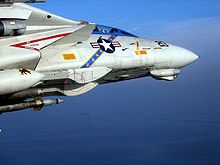
While upgrades had kept the F-14 competitive with modern fighter aircraft technology, Cheney called the F-14 1960s technology. Despite an appeal from the Secretary of the Navy for at least 132 F-14Ds and some aggressive proposals from Grumman for a replacement,[72] Cheney planned to replace the F-14 with a fighter that was not manufactured by Grumman. Cheney called the F-14 a "jobs program", and when the F-14 was canceled, an estimated 80,000 jobs of Grumman employees, subcontractors, or support personnel were affected.[73] Starting in 2005, some F-14Ds received the ROVER III upgrade.
Projected variants
The first F-14B was to be an improved version of the F-14A with more powerful "Advanced Technology Engine" F401 turbofans. The F-14C was a projected variant of this initial F-14B with advanced multi-mission avionics.[74] Grumman also offered an interceptor version of the F-14B in response to the U.S. Air Force's Improved Manned Interceptor Program to replace the Convair F-106 Delta Dart as an Aerospace Defense Command interceptor in the 1970s. The F-14B program was terminated in April 1974.[75]The last "Tomcat" variant was the ASF-14 (Advanced Strike Fighter-14), Grumman's replacement for the NATF concept. By all accounts, it would not be even remotely related to the previous Tomcats save in appearance, incorporating the new technology and design know-how from the Advanced Tactical Fighter (ATF) and Advanced Tactical Aircraft (ATA) programs. The ASF-14 would have been a new-build aircraft; however, its projected capabilities were not that much better than that of the (A)ST-21 variants.[77] In the end the Attack Super Tomcat was considered to be too costly. The Navy decided to pursue the cheaper F/A-18E/F Super Hornet to fill the fighter-attack role.[76]
Operators
- Islamic Republic of Iran Air Force
- 72nd TFS: F-14A, 1976–1985
- 73rd TFS: F-14A, 1977–1985
- 81st TFS: F-14A, 1977–present
- 82nd TFS: F-14A, 1978–present
- 83rd Tomcat Flight School: F-14A, 1978–1979
- 83rd TFS: F-14A, renamed former 62nd TFS[78]
- United States Navy: operated F-14 from 1974 to 2006
- Navy Fighter Weapons School (TOPGUN) (Merged with Strike University (Strike U) to form Naval Strike and Air Warfare Center (NSAWC) 1996)
- VF-126 Bandits (Disestablished 1 April 1994)
- VF-1 Wolfpack (Disestablished 30 September 1993)
- VF-2 Bounty Hunters (Pacific Fleet through 1996, Atlantic Fleet 1996-2003, Pacific Fleet 2003–present; redesignated VFA-2 with F/A-18F, 1 July 2003)
- VF-11 Red Rippers (Redesignated to VFA-11 with F/A-18F, May 2005)
- VF-14 Tophatters (Redesignated VFA-14 with F/A-18E, 1 December 2001, and transferred to Pacific Fleet, 2002)
- VF-21 Freelancers (Disestablished 31 January 1996)
- VF-24 Fighting Renegades (Disestablished 20 August 1996)
- VF-31 Tomcatters (Redesignated VFA-31 with F/A-18E, October 2006)
- VF-32 Swordsmen (Redesignated VFA-32 with F/A-18F, 1 October 2005)
- VF-33 Starfighters (Disestablished 1 October 1993)
- VF-41 Black Aces (Redesignated VFA-41 with F/A-18F, 1 December 2001)
- VF-51 Screaming Eagles (Disestablished 31 March 1995)
- VF-74 Bedevilers (Disestablished 30 April 1994)
- VF-84 Jolly Rogers (Disestablished 1 October 1995; squadron heritage and nickname transferred to VF-103)
- VF-102 Diamondbacks (Redesignated VFA-102 with F/A-18F, 1 May 2002, and transferred to Pacific Fleet)
- VF-103 Sluggers/Jolly Rogers (Redesignated VFA-103 with F/A-18F, 1 May 2005)
- VF-111 Sundowners (Disestablished 31 March 1995; reestablished as VFC-111 in Naval Air Force Reserve with Northrop F-5N and F-5F, 1 November 2006)
- VF-114 Aardvarks (Disestablished 30 April 1993)
- VF-142 Ghostriders (Disestablished 30 April 1995)
- VF-143 Pukin' Dogs (Redesignated VFA-143 with F/A-18E, early 2005)
- VF-154 Black Knights (Redesignated VFA-154 with F/A-18F, 1 October 2003)
- VF-191 Satan's Kittens (Disestablished 30 April 1988)
- VF-194 Red Lightnings (Disestablished 30 April 1988)
- VF-211 Fighting Checkmates (Pacific Fleet through 1996, then transferred to Atlantic Fleet; redesignated VFA-211 with F/A-18F, 1 October 2004)
- VF-213 Black Lions (Pacific Fleet through 1996, then transferred to Atlantic Fleet; redesignated VFA-213 with F/A-18F, May 2006)
- Navy Fighter Weapons School (TOPGUN) (Merged with Strike University (Strike U) to form Naval Strike and Air Warfare Center (NSAWC) 1996)
- Naval Air Systems Command Test and Evaluation Squadrons
- VX-4 Evaluators (Disestablished 30 September 1994 and merged into VX-5 to form VX-9)
- VX-9 Vampires (Currently operates F/A-18C/D/E/F, EA-18G, EA-6B, AV-8B, AH-1 and UH-1)
- VX-23 Salty Dogs (Currently operates F/A-18A+/B/C/D/E/F, EA-6B, EA-18G and T-45)
- VX-30 Bloodhounds (Currently operates P-3, C-130, S-3)
- Fleet Replacement Squadrons
- Naval Air Force Reserve Squadrons
- Naval Air Force Reserve Squadron Augmentation Units (SAUs)
Aircraft on display
- Bureau Number (BuNo) – Model – Location – Significance
- F-14A
- 157982 - Cradle of Aviation Museum, Garden City, New York. Prototype #3 Nonstructural Demonstration Testbed.[83]
- 157984 - National Naval Aviation Museum, Naval Air Station Pensacola, Florida. Fifth F-14 manufactured and one of the prototypes used in flight testing. Mounted on pedestal at entrance to museum.[84]
- 157988 - NAS Oceana Air Park, Virginia.[85]
- 157990 - March Field Air Museum, Riverside, California.[86]
- 158623 - Naval Base Ventura County, NAS Point Mugu, California. Pedestal mount at Front Gate Airpark.[87]
- 158978 - USS Midway Museum, San Diego, California.[88]
- 158985 - Yanks Air Museum, Chino, California.[89]
- 158998 - Air Victory Museum, Lumberton, New Jersey.[90]
- 158999 - Naval Air Station Joint Reserve Base Fort Worth (former Carswell AFB), Fort Worth, Texas.[91]
- 159025 - Patriot's Point Naval and Maritime Museum, Charleston, South Carolina.[92]
- 159445 - Naval Station Norfolk (former Naval Air Station Norfolk) East Gate Airpark, Virginia.[93]
- 159448 - Naval Inventory Control Point, Pennsylvania.[94]
- 159455 - NAS Patuxent River, Lexington Park, Maryland. Former VX-23 flight test squadron aircraft.[95]
- 159600 - Fort Worth Aviation Museum, Fort Worth, Texas[96]
- 159620 - NAF El Centro, California.[97]
- 159626 - Naval Strike and Air Warfare Center, Naval Air Station Fallon, Nevada.[98]
- 159631 - San Diego Aerospace Museum, San Diego, California.[99]
- 159829 - Wings Over the Rockies Air and Space Museum, former Lowry AFB, Denver, Colorado. From VF-211, later used for aircraft maintenance training by Naval Air Reserve Center Denver at Buckley AFB.[100]
- 159830 - Western Museum of Flight, Hawthorne, California.[101]
- 159848 - Tillamook Air Museum, Tillamook, Oregon.[102]
- 159853 - Defense Supply Center Richmond, Richmond, Virginia.[103]
- 159856 - Naval Air Facility El Centro, California.[104]
- 160382 - Museum of Flight, Tukwila, Washington. VF-84 "Jolly Rogers" AJ202. Stationed on the USS Nimitz. This aircraft, as well as several other F-14As from the famous "Jolly Rogers" squadron, appear in the 1980 film The Final Countdown which was filmed on board the USS Nimitz. On loan from the National Museum of Naval Aviation at Pensacola, Florida.[105]
- 160386 - Naval Air Station Joint Reserve Base Willow Grove, Pennsylvania.[106]
- 160391 - Texas Air Museum, Lubbock, Texas.[107]
- 160395 - Air Zoo, Kalamazoo, Michigan.[108]
- 160401 - Fleet Area Control and Surveillance Facility Virginia Capes (FACSFAC VACAPES), Naval Air Station Oceana, Virginia.[109]
- 160403 - American Airpower Heritage Museum, Midland, Texas.[110]
- 160411 - Empire State Aerosciences Museum, Glenville, New York.[111]
- 160658 - NAES Lakehurst, New Jersey.[112]
- 160661 - U.S. Space and Rocket Center's Aviation Challenge facility in Huntsville, Alabama.[113]
- 160666 - Western Aerospace Museum, Oakland, California. Originally delivered to VF-111 in 1978, subsequently reassigned to NAVAIR test duties, permanently modified for development of follow-on avionics and weapons systems.[114]
- 160684 - Pima Air and Space Museum, adjacent to Davis-Monthan AFB, Tucson, Arizona. Repainted in its original markings as "NL 211" of VF-111 aboard USS KITTY HAWK (CV-63), as this particular aircraft appeared in its initial operational squadron service, circa 1978-1981.[115]
- 160694 - USS Lexington Museum, Corpus Christi, Texas. - Painted with Hi-Vis markings of VF-103 "Jolly Rogers". Aircraft is on loan from the National Museum of Naval Aviation at NAS Pensacola, Florida.[116]
- 160889 - Pacific Coast Air Museum at Charles M. Schulz Sonoma County Airport, Santa Rosa, California.[117]
- 160898 - Palm Springs Air Museum, Palm Springs, California.[118]
- 160902 - Riverhead, New York.[119]
- 160903 - Mid-America Air Museum, Liberal Mid-America Regional Airport, Liberal, Kansas.[120]
- 160909 - Dobbins Air Reserve Base, Atlanta, Georgia.[121]
- 160914 - Willmar Municipal Airport, Wilmar, Minnesota[122]
- 161134 - Valiant Air Command Warbird Museum, Space Coast Regional Airport, Titusville, Florida.[123]
- 161163 - Prairie Aviation Museum, Bloomington, Illinois. Depot Level Conversion performed September 1991. Retired as MODEX 205 of Fighter Squadron 213 (VF-213), Black Lions.[124]
- 162591 - Quonset Air Museum, Quonset State Airport (former Naval Air Station Quonset Point), North Kingstown, Rhode Island.[125]
- 162592 - Ronald Reagan Presidential Foundation and Library (Painted Buno 160403).
- 162608 - Southern Museum of Flight, Birmingham, Alabama.[126]
- 162689 - USS Hornet (CV-12), USS Hornet Museum, former Naval Air Station Alameda, Alameda, California.[127]
- 162694 - MAPS Air Museum, North Canton, Ohio.[128]
- 162710 - National Naval Aviation Museum, Naval Air Station Pensacola, Florida.[129]
- F-14B
- 157986 - USS Intrepid (CV-11), Intrepid Sea-Air-Space Museum, Manhattan, New York. 7th Tomcat built, retained as research and development airframe.[130]
- 161598 - Tulsa Air and Space Museum, Tulsa, Oklahoma. It has VF-41 "Black Aces" markings.[131]
- 161605 - Wings of Eagles Discovery Center/National Warplane Museum, Horseheads, New York.[132]
- 161615 - Combat Air Museum, Topeka, Kansas.[133]
- 161620 - Selfridge Military Air Museum, Selfridge Air National Guard Base, Mount Clemens, Michigan.[134]
- 161623 - Patuxent River Naval Air Museum, Naval Air Station Patuxent River, Lexington Park, Maryland. It is a former VX-23 flight test squadron aircraft.[135]
- 162912 - Grissom Air Museum, Grissom Air Reserve Base (former Grissom AFB), Indiana.[136]
- 162916 - Richard J. Goss Post #8896, East Berlin, Pennsylvania.[137]
- 162926 - New England Air Museum, Windsor Locks, Connecticut.[138]
- F-14D(R)
- 159600 - OV-10 Bronco Museum, Fort Worth, Texas. On loan from the National Museum of Naval Aviation, NAS Pensacola, Florida. Nicknamed "Christine", it was the longest-serving F-14 Tomcat in U.S. Navy. Remanufactured from F-14A to F-14D(R) configuration, it was originally built in 1976 and made the final combat deployment/cruise of the F-14 in 2006.[139]
- 159610 - Smithsonian National Air & Space Museum, Steven F. Udvar-Hazy Center, Chantilly, Virginia. This F-14 was one of those involved in the second Gulf of Sidra incident.[140]
- 159619 - Florida Air Museum at Sun 'n Fun, Lakeland Linder Regional Airport, Lakeland, Florida.[141]
- 161159 - National Naval Aviation Museum, Naval Air Station Pensacola, Florida. Completed the last combat flight and the last combat carrier arrested landing (trap) by a U.S. Navy F-14.[84]
- 161166 - Carolinas Aviation Museum, Charlotte, North Carolina.[142]
- 162595 - Naval Test Wing Atlantic, Naval Air Station Patuxent River, Maryland.[143]
- F-14D
- 163893 - main gate, Arnold Engineering and Development Center, Arnold AFB, Tennessee.[144]
- 163897 - Aerospace Museum of California, McClellan Airfield (former McClellan AFB and current Coast Guard Air Station Sacramento), Sacramento, California.[145]
- 163902 - Hickory Aviation Museum at Charlotte Douglas International Airport, Hickory, North Carolina. VF-31 Tomcatters aircraft Modex number 107; flew the F-14 retirement ceremony with LCDR Chris Richard and LT Mike Petronis at the controls.[146]
- 163904 - Pacific Aviation Museum, Ford Island, Joint Base Pearl Harbor-Hickam, Hawaii.[147]
- 164342 - Wings Over Miami, Miami, Florida.[148]
- 164343 - Evergreen Aviation Museum, McMinnville, Oregon.[149]
- 164346 - Virginia Aviation Museum, Richmond, Virginia. On loan from National Museum of Naval Aviation, Pensacola, Florida. Last Tomcat to operationally trap aboard a U.S. Navy aircraft carrier.[150]
- 164350 - Texas Aviation Hall of Fame, Galveston, Texas.[151]
- 164601 - Castle Air Museum at former Castle AFB, Atwater, California.[152]
- 164603 - Grumman Headquarters, Bethpage, New York. Felix 101 from VF-31 is the last Tomcat to fly in U.S. Navy service. Final flight was from NAS Oceana, Virginia to the American Airpower Museum at Republic Airport Long Island, New York on 4 October 2006 were it was displayed for a year and a half before being moved to Grumman Plant 25.[153]
- 164604 - NAS Oceana Memorial Park, Naval Air Station Oceana, Virginia. Last F-14 manufactured, assigned to VX-4, later VX-9, at Naval Air Station Point Mugu, California during its operational service and used the callsign "Vandy 1".[154]
Specifications (F-14D)
General characteristics- Crew: 2 (Pilot and Radar Intercept Officer)
- Length: 62 ft 9 in (19.1 m)
- Wingspan:
- Spread: 64 ft (19.55 m)
- Swept: 38 ft (11.58 m)
- Height: 16 ft (4.88 m)
- Wing area: 565 ft² (54.5 m²)
- Airfoil: NACA 64A209.65 mod root, 64A208.91 mod tip
- Empty weight: 43,735 lb (19,838 kg)
- Loaded weight: 61,000 lb (27,700 kg)
- Max. takeoff weight: 74,350 lb (33,720 kg)
- Powerplant: 2 × General Electric F110-GE-400 afterburning turbofans
- Dry thrust: 13,810 lbf (61.4 kN) each
- Thrust with afterburner: 27,800 lbf (123.7 kN) each
- Maximum fuel capacity: 16,200 lb internal; 20,000 lb with 2x 267 gallon external tanks[34]
- Maximum speed: Mach 2.34 (1,544 mph, 2,485 km/h) at high altitude
- Combat radius: 500 nmi (575 mi, 926 km)
- Ferry range: 1,600 nmi (1,840 mi, 2,960 km)
- Service ceiling: 50,000+ ft (15,200 m)
- Rate of climb: >45,000 ft/min (229 m/s)
- Wing loading: 113.4 lb/ft² (553.9 kg/m²)
- Thrust/weight: 0.92
- Guns: 1× 20 mm (0.787 in) M61 Vulcan 6-barreled Gatling cannon, with 675 rounds
- Hardpoints: 10 total: 6× under-fuselage, 2× under nacelles and 2× on wing gloves[157][N 2] with a capacity of 14,500 lb (6,600 kg) of ordnance and fuel tanks[158]
- Missiles:
- Air-to-air missiles: AIM-54 Phoenix, AIM-7 Sparrow, AIM-9 Sidewinder
- Loading configurations:
- 2× AIM-9 + 6× AIM-54 (Rarely used due to weight stress on airframe)
- 2× AIM-9 + 2× AIM-54 + 3× AIM-7 (Most common load during Cold War era)
- 2× AIM-9 + 4× AIM-54 + 2× AIM-7
- 2× AIM-9 + 6× AIM-7
- 4× AIM-9 + 4× AIM-54
- 4× AIM-9 + 4× AIM-7
- Bombs:
- JDAM precision-guided munition (PGMs)
- Paveway series of laser-guided bombs
- Mk 80 series of unguided iron bombs
- Mk 20 Rockeye II
- Others:
- Tactical Airborne Reconnaissance Pod System (TARPS)
- LANTIRN targeting pod
- 2× 267 US gal (1,010 l; 222 imp gal) drop tanks for extended range/loitering time
- Hughes AN/APG-71 radar
- AN/ASN-130 INS, IRST, TCS
- Remotely Operated Video Enhanced Receiver (ROVER) upgrade
Tomcat logo
The Tomcat logo design came when Grumman's Director of Presentation Services, Dick Milligan, and one of his artists, Grumman employee Jim Rodriguez, were asked for a logo by Grumman's Director of Business Development and former Blue Angels #5 pilot, Norm Gandia.[159] Per Rodriguez, "He asked me to draw a lifelike Tomcat wearing boxing gloves and trunks sporting a six-shooter on his left side; where the guns are located on the F-14, along with two tails." The Cat was drawn up after a tabby cat was sourced and used for photographs, and named "Tom". The logo has gone through many variations, including one for the then-Imperial Iranian Air Force F-14, called "Ali-cat". The accompanying slogan "Anytime Baby!" was developed by Norm Gandia as a challenge to the U.S. Air Force's McDonnell Douglas F-15 Eagle.[159][160]TOP GUN Day Special: The Super Tomcat That Was Never Built

Tyler Rogoway
Filed to: Fighters 5/13/14 4:29pm
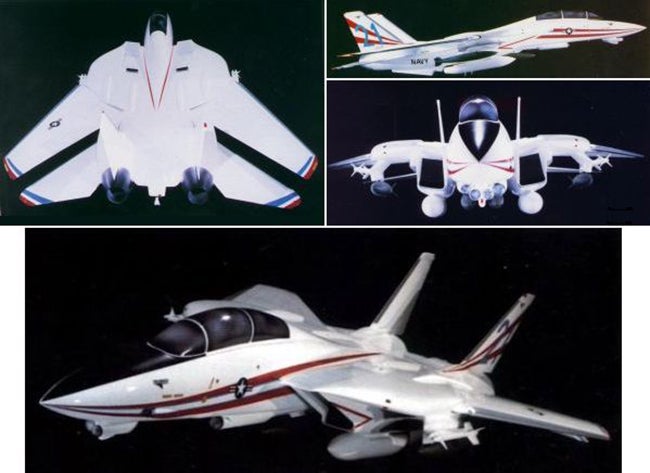
In light of it being Top Gun Day I think it would be proper to take a look back to see how the true star of the movie, the F-14 Tomcat, could have lived on in various forms far past its 2006 retirement date.
In our reality, the F/A-18E/F Super Hornet became the US Navy's vanguard fighter of the 21st century as a result of the boondoggle that was the A-12 Avenger program. After massive cost overruns, weight increases and huge delays, then Defense Secretary Dick Cheney axed the stealthy carrier-borne flying wing attack jet leaving a huge hole in NAVAIR's future inventory.
This was back in 1991, the Cold War had just ended and we just got done kicking the ass of one of the world's largest standing armies. Congress had been talked into high-risk, hugely aggressive defense programs for decades and they had had enough. The "peace dividend" sentiment was on the rise and defense budgets were beginning to fall.

With the A-6E TRAM Intruder's retirement imminent and in the vacuum created by the cancelled A-12 program, manufactures starting throwing out "logical growth" designs based on existing platforms. The hope was that if aircraft manufacturers make an almost entirely new aircraft look like an existing type, while also giving them a familiar "evolutionary" designation, Congress would see the product as a low risk, low-cost upgrade of a proven platform and thus move forward with its procurement. At the same time the NATF program (the equivalent to the USAF's Advanced Tactical Fighter program) was in the works, but the costs and timeline for its development would have been massive, and in light of what happened to the stealthy A-12 "Flying Dorito," it was clear that something simpler was needed. In the end this "low risk" and familiar design concept worked via the eventual development and procurement of the F/A-18E/F Super Hornet. Yet in some people's opinion, it worked for the wrong aircraft.
The Super Tomcat 21 grew out of a previous proposal made by Grumman after the collapse of the A-12 program called the Tomcat Quick Strike. Quick Strike was meant to be an upgrade for existing F-14s by giving them high-end navigation and targeting pods similar to the USAF's LANTIRN system, along with upgraded ground attack modes for F-14D's APG-71 Radar (based on the aircraft's original AWG-9 radar) and the ability to carry more standoff weaponry like the AGM-84E SLAM and AGM-88 HARM.
Quick Strike was aimed more at cheaply picking up the Intruder's slack than at replacing the A-12's high-end capability, and was seen at the time as an insufficient technological leap over the F-14B and D models already in service. Also, rumors that an inexpensive clean sheet next generation Hornet design was in the works over at McDonald Douglas did not help Quick Strike's attractiveness. So Grumman came back to the Navy with a true "Super Tomcat," called the Super Tomcat 21.
A side note: the Quick Strike concept would be the impetus for outfitting the F-14 fleet with LANTIRN targeting pods capability. This relatively austere upgrade turned out to be one of the best investments NAVAIR had ever made in an existing platform and the mighty air defense focused Tomcat would become the tactical bomber of choice by the late 1990s and the airborne forward air controller of choice, otherwise known as FAC(A), by the early 2000s.

The Super Tomcat 21 would be a modification of the original F-14 design and it was to feature GE-F110-129 motors that would allow the Tomcat to super-cruise (achieve mach 1+ without using afterburner) continuously at mach 1.3. Additionally, the jet would have an upgraded APG-71 radar, modified and enlarged control surfaces, and enlarged leading edge root extensions (LERX) that would house more fuel and enhance the jet's low speed handling capabilities. Thrust vectoring nozzles tied directly to a new digital flight control system were also an option. These modifications would give the "Turkey Bird" true super-maneuverability and eye-watering acceleration and sustained speed. Additionally, super-cruise combined with its additional internal fuel carriage capacity would have given the Super Tomcat much greater range than it already had. The jet would also be able to carry targeting and navigation pods, giving it true multi-role capability. Finally, a new single-piece windscreen would be added to provide much better forward visibility.
There was also a more deep strike optimized version floated called Attack Super Tomcat 21. From an avionics standpoint this jet would be a major leap forward compared in comparison with its predecessors, with an attack FLIR and Terrain Following Radar housed in the Phoenix missile mount's aerodynamic fairings under the fuselage. The Infra Red Search & Track system and Television Camera System would be mounted in under-nose pods similar to the F-14D's TCS/IRST pod. Also, the aircraft would have upgraded cockpit avionics including a new wide angle heads up display (HUD) that would be capable of projecting the navigational FLIR's imagery. New mission computers and an upgraded self defense suite was included in the more elaborate Attack Super Tomcat 21 proposal. The Super Tomcat 21 and the Attack Tomcat 21 were pitched as a concept for remanufacturing existing F-14s or for new build aircraft.
A side note: I once talked to an accomplished engineer that worked for Grumman on the Super Tomcat 21 proposal. He told me that the performance models they were seeing with the Super Tomcat design were absolutely stunning and the jet's low speed handling, especially with thrust vectoring and the bigger engines, and the sheer amount of territory it could cover in a single mission were unprecedented. This man went on to work for "other contractors" on major fighter programs, but he maintains that the Super Tomcat's maneuvering performance and ability to operate as a fighter independent of tanker assets over large distances has still not been accomplished in any US or foreign design to this day. He did mention that he does see a large degree of the Super Tomcat's potential in the Russia's late model Flanker series, especially with its thrust vectoring and large internal fuel, but according to him it still does not really compare.
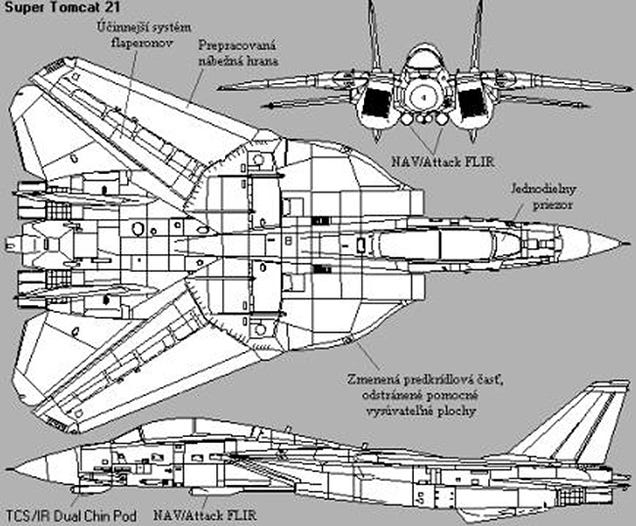
The Tomcat's ultimate proposed configuration was known as the "ASF-14" would be a new build, highly updated version of the legendary F-14. A true "Super Tomcat" in every sense of the word, the machine would boast an even larger increase in internal fuel over the Super Tomcat 21 via thicker wings, the gutting of bulky older generation sub-systems and the use of carbon fiber structural components to save weight and volume. It would initially utilize the same motors as the Super Tomcat, but there was talk of eventually rolling the F-22 and NATF's F-119 or F120 engines into the design at a later date. I was told that the Tomcat's super-cruise ability with these advanced engines would be limited more by heat accumulation than speed itself (think numbers over mach two).
Even without thrust vectoring, the aerodynamic enhancements found on the ASF-14 would allow the jet to reach over 77 degrees of sustained AoA, but thrust vectoring was also to be part of the new design which would have made it the most maneuverable fighter of all time. Additionally, the ASF-14 would have been built with a top of the line self defense and countermeasure suite along with ability to perform "wild weasel" suppression/destruction of enemy air defenses (SEAD/DEAD) missions.
Possibly the best part of about the ASF-14 is that it would be an entirely new aircraft, much along the same lines as the Super Hornet. This means old 1960's era sub-systems that were heavy and complex would be replaced with modular components. All of the jet's hydraulic and electrical systems that gave legacy Tomcat maintainers such headaches over the years would have been replaced with greatly simplified systems. Furthermore, many structural components would be made out of carbon fiber instead of aluminum or titanium. This would allow the new Tomcat to be only slightly heavier in gross weight (about 1200 pounds) than its predecessor, while gaining thousands of pounds of fuel. There was even talk that some stealthy characteristics would be applied to the ASF-14, this may have included radar baffles over it engines' fan faces and "edge-alligned" gear doors and access points.
The cockpit would have featured an all glass design with helmet mounted displays for both the pilot and the RIO/WSO. The most exciting part of the avionics suite would have made use of the Tomcat's massive radar aperture. A mammoth active electronically scanned array (AESA) radar would have been fitted and provided with immense amounts of power for interlaced air-to-air and air-to-ground operations or even standoff electronic attack. You can see how incredible the ASF-14s AESA capability would have matured into by looking at the current APG-63V3 AESA radar upgrade program for the F-15. The APG-63V3 is actually more capable in some respects than the F-22A's APG-77 AESA radar because it is larger in diameter, allowing for more transit/receive modules to be utilized, and it is newer in its design. The Tomcat was built originally for the massive Hughes AWG-9 fire control radar, the largest radar ever deployed on a US fighter, so there is a LOT of real estate up front for the mother of all fighter jet AESA radar arrays to have been fitted.
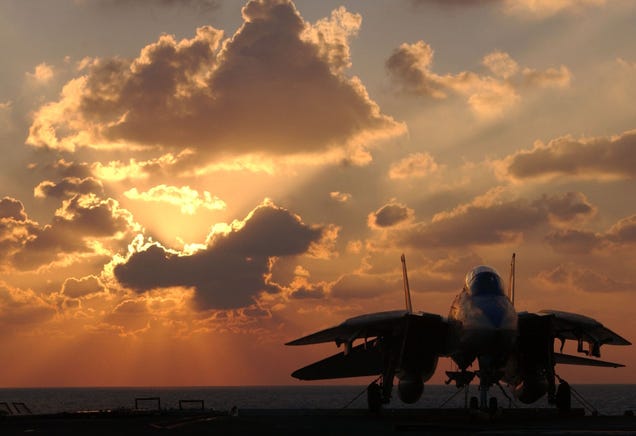
There is no doubt that the F/A-18E/F Super Hornet and E/A-18G Growler programs are impressive. They have delivered a so called "80% solution" to NAVAIR on time and on budget consistently for a decade and a half. The jets are comparatively reliable and have good commonality with the legacy Hornet for aircrew and maintenance crossover familiarity. Although as a replacement for both the F-14 and the A-6, the Super Hornet lacks greatly in some very important respects. These being mainly range and speed.
The Super Hornet, or "Rhino" as it is now called, is not nearly as thirsty as its smaller A/B/C/D "legacy" hornet brethren, but it still lacks range and endurance. It is also a bit of a pig aerodynamically. Sporting a thicker wing and a larger, less aerodynamically efficient airframe than its progenitor, the Super Hornet is not that fast when compared to the Tomcat or even the legacy Hornet for that matter, especially when there are stores, or even just pylons hung under its big wings.
The pylons are probably the most appalling factor of the E/F/G Super Hornet models. They are actually canted out 3 degrees due to weapons separation issues during testing. This means that they are acting not just as parasitic drag, but as little speed-brakes of sorts whenever they are present and seeing as there is no weapons bay on the Super Hornet, they are almost always present. The more you store on these pylons the more surface area is meeting airflow head-on, causing a sizable drag and fuel burn penalty. This penalty would be partly solved by upgrading the existing Super Hornet fleet to Block III/Advanced configurations, with a stealthy weapons pod and conformal fuel tanks, but this is entirely another story.
In contrast, the F-14 carries the majority of its weapons in its "tunnel" recess, part of its overall lifting body design, that runs between the jet's two engine nacelles. This configuration greatly reduces drag in comparison to aircraft that carry their weapons on straight pylons on their wings.
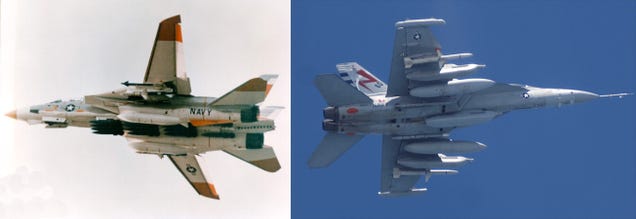
The Super's big wings and control surfaces do help in the slow speed handling regime, but that area of the envelope is becoming less important with the proliferation of helmet mounting sighting systems paired with high off-boresight heat seeking missiles. In other words, you now only have to see your enemy to kill them in a dogfight, as opposed to getting the fighter's nose, and thus its weapons, pointed directly at them. This larger wing and weak aerodynamic shaping also means that the Super Hornet does not accelerate quickly with normal stores and even going over mach one can be challenging when configured in certain ways or when flying at certain altitudes.
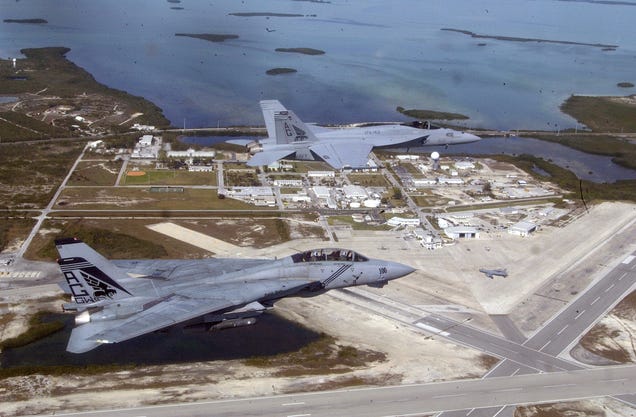
To sum it up, the Super Hornet is an efficient and very smart flying compromise, capable of everything but master at nothing. If you want to get somewhere quick in it, prepare to burn a lot of gas in the process and you will still get there slower than most all other advanced fighters. So maybe the wrong machine was super-sized by the US Navy, especially concerning it was a one-size fits all design.
Taking a light strike fighter and turning it into a medium strike fighter is far less than ideal. Taking a heavy fighter and turning it into better heavy strike fighter is much more relevant especially considering the unique challenges of the carrier environment. The ASF-14 would have been the pinnacle of American non-stealth fighter aircraft, offering blistering speed, immense range, long on station time, advanced sensors and super-maneuverability all in a proven carrier capable package. In fact, with the upgrades planned under the ASF-14 model this "ultra-Tomcat" of sorts would have been more or a regional fighter and attack aircraft than a traditional fighter, which would have made a ton of sense over the last 13 years of war and in the present where America's strategic focus is turning towards the vast expanses of the Pacific Theater.
Sadly the ASF-14 proposal never came to reality as the USN thought it would be too expensive in the long run and opted with the Super Hornet instead. So next time you hear about how awesome the avionics integration is on the Super Hornet or the Growler, ponder on the possibility of how much more effective those avionics would have been if they were packed into an airframe that can carry them hundreds more miles away from the Carrier Group at extremely high sustained speeds.
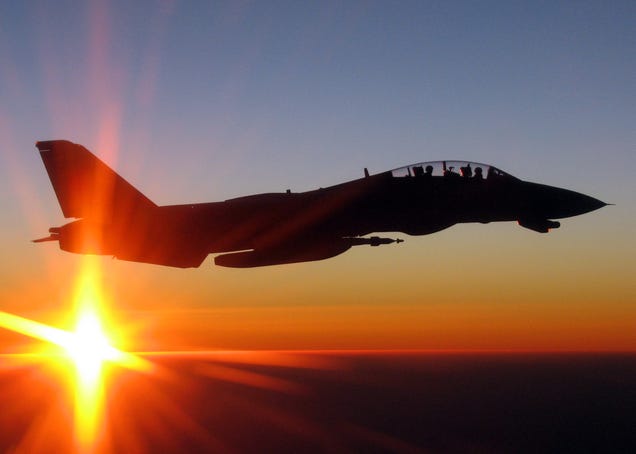
Adapted from a prior piece at Aviationintel.com, pictures via public domain and US Navy.
Tyler Rogoway is a defense journalist and photographer that maintains the website Foxtrot Alpha for Jalopnik.com You can reach Tyler with story ideas or direct comments regarding this or any other defense topic via the email address Tyler@Jalopnik.com


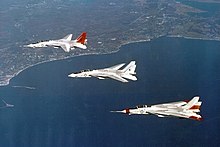





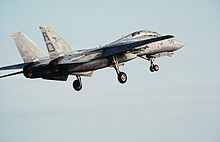




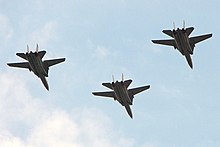
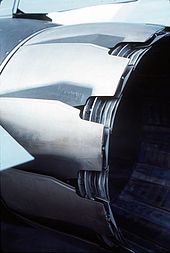

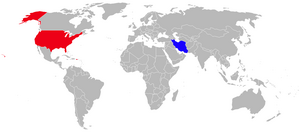


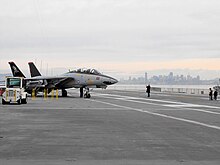

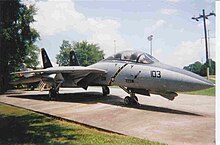
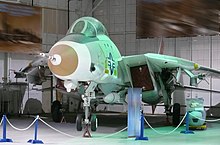
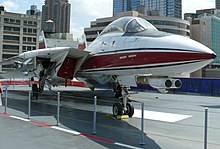



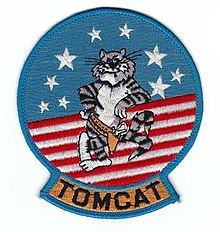
No comments:
Post a Comment